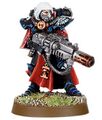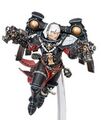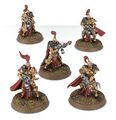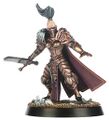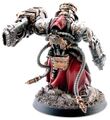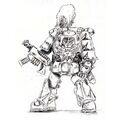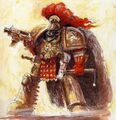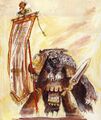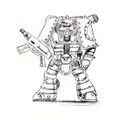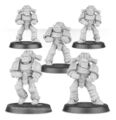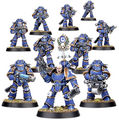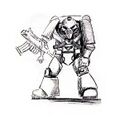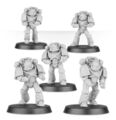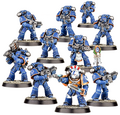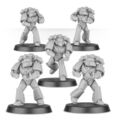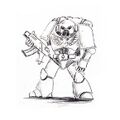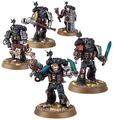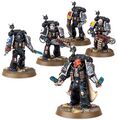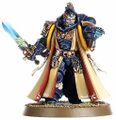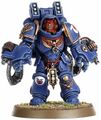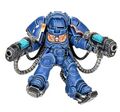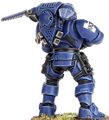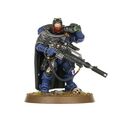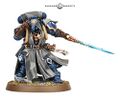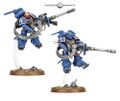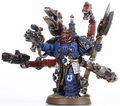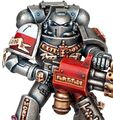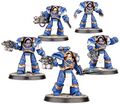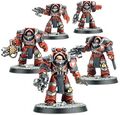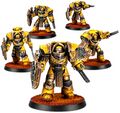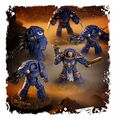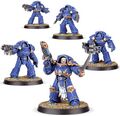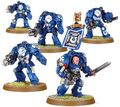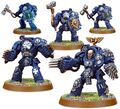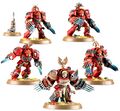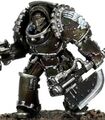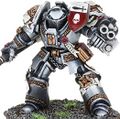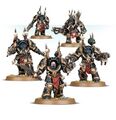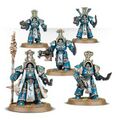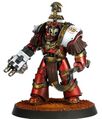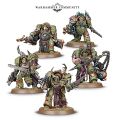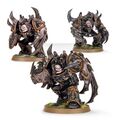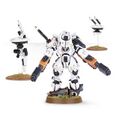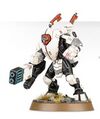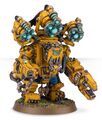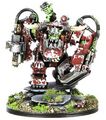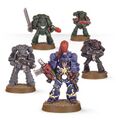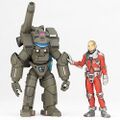Power Armour: Difference between revisions
(→X-COM) |
|||
| Line 985: | Line 985: | ||
It also can have WH40k armor and weapons. As there are now several 40k mods on the Steam Workshop. | It also can have WH40k armor and weapons. As there are now several 40k mods on the Steam Workshop. | ||
Mods for the old EU/EW Mecs and Power armor also exist. Though you need the corresponding DLCs to use them. | |||
=Warmachine= | =Warmachine= | ||
Revision as of 14:37, 25 August 2021

"Feels like you can take on the world in there, doesn't it?"
- – Danse, Fallout 4
Power Armour, also known as Power Armor to Americans, is a science fiction concept of mechanized armor which increases the strength, speed, and reflexes of those who wear it. It is featured heavily in science fiction/fantasy settings such as Iron Man or Warhammer 40,000. The idea of Powered Armor was invented by E.E. Smith and ripped off or borrowed and refined by other writers.
Starship Troopers
Like so many military science-fiction concepts, the modern idea of powered armor dates back to the Mobile Infantry of Heinlein's Starship Troopers. The "Marauder" suit is bulky, with integrated thrusters and heavy weapons (including nuclear weapons and heavy explosives, carried as easily as a human soldier carries grenades). Their primary purpose is not to destroy indiscriminately (though they certainly can), but to "make war as personal as a punch on the nose" -- to drop in and destroy with precision, in order to break the enemy in exactly the right way. In other words, it's much like Crisis battlesuits with less weeaboo and more humanity fuck yeah inside.
Heinlein never discusses pauldrons, but the Space Marines certainly take after the Mobile Infantry's other aspects.The dudes from the book not the movie. That was a parody anyway.
- Marauder: The basis infantry suit. Can carry more weapons than vintage Doomguy. Basic equipment includes radar and multi-spectrum vision aids.
- Scout: Lean on weapons, heavy on jump fuel. Much more mobile than the standard model.
- Command: Scout suit with more comm gear and gyros for inertial dead reckoning navigation. Command suits in comm range of each other can compare their DR nav data to determine relative position without any battlefield nav aids.
So how many weapons we looking at here? Well, in the first chapter of the book, Rico is participating in a quick raid on an alien city. Their objective was to smash and run, inflicting as much damage as possible but avoiding engagement with defense forces. For this missions he dropped into battle with: a rifle, a heavy flamer, a handheld flamer, an automatic grenade launcher (called a Y-rack) and multiple reloads, conventional thrown grenades, incendiary micro grenades (called firepills), and one psy-ops grenade (a talking timebomb). And topping it off since Rico was a non-com working on the flank, he was issued a rocket launcher with four low-yield nuclear rockets.
Warhammer 40,000
Because 40k has a huge hard on for Space Marines, and because no super soldier worth his genetic enhancements will go into battle without super armaments, 40k has developed nearly as large a hard on for power armor.
Human Power Armour
Virtually identical to Space Marine power armor (More can be read below), these suits of armor are scaled down to fit regular humans (notice that this is the reverse of what it would have been 10,000 years ago). Human power armour is relatively quite rare, since it occurred to somebody that making good protection being an affordable and wide-spread asset would severely impinge on the current state of grimdark, not to mention expensive.
Without the extra room and black carapace interface Marine armor provides, many suits of human power armor don't offer the same degree of protection, as much strength enhancement, or as many subsystems found in Marine armor. Still, the wearer will still be stronger, better protected, and better equipped than the guy in cardboard. There are a few variants, including a lighter suit and one for Chaos-fighting Inquisitors. Because these things are still super-rare, usually only people rolling in money, tech fetishists, and those able to declare not giving them power armor is heresy, will have any.
Ignatus Pattern Armour
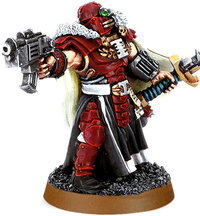
The most 'common' type of non-Astartes and non-Sororitas Power Armour.
The Ignatus pattern power armours are all fine examples of Mechanicus artisans. Each of them are individuality crafted only for representatives of the Inquisition. Of course not as durable as Adeptus Astartes power armours, the Ignatus-pattern is far better designed than those sold to nobles, rogue traders and other agents of the Imperium.
Like every other power armour variant, Ignatus armour is made of thick ceramite armour plates and incorporated electro-muscles so the user can even use the power armour in the first place. The optional helmet protects the wearer from toxic gasses, allows the wearer to breathe underwater, and even survive in a vacuum as long as the suit has power. The helmet has photo-visors so the user can see in the dark and an automatically closing visor renders blind-grenades useless against the wearer. They also have micro-beads and an integral auspex which can be controlled by speaking to the armour’s machine spirit, or the wearer could commune with his armour directly if they have a cerebral plug, MIU, or similar device. It is also possible to use a backpack for the suit which acts as an external power source. With this power-backpack, the wearer can use his armour for five continuous days in battle conditions.
Because the Inquisition often has to deal with Ruinous Powers and other heretical forces, Ignatus suits are commonly inlaid with hexagrammic wards.
-
Inquisitor -
Ordo Xenos -
Delphis Mk.II: Ironclad
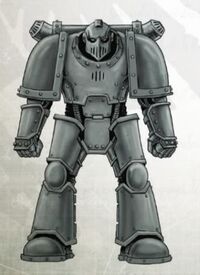
A power armour that looks like something an Astartes would wear.
The Delphis Mk.II "Ironclad" Heavy Power Armour is a variant of standard non-Astartes power armour. It features increased personal protection at the cost of agility, with huge plates of Plasteel covering the flatter areas of the body. Exposed servo-mechanisms run along the legs and arms and elaborate bracing runs across the spine.
The helmet is small by comparison and the gauntlets are unwieldy to the point where basic actions beyond wielding a weapon is impossible. The power cell system in the rear has several thermal fins protruding to shed away excess heat. Ranks of power cells mounted on the rear provide 12 hours of continuous operation before recharging is needed, but require a day of recharging after each prolonged use. The suit is also a fully enclosed void suit and incorporates an inbuilt auspex, good craftsmanship photo-visors, an incorporated vox, and a pair of recoil gloves. If the suit becomes unpowered, vents open automatically in the helmet to ensure the wearer does not suffocate.
Each suit is a personal heirloom item, colourful paintwork and elaborate scrolls delineating the history of the various users cover the surface; some users have also added additional ornamental shields to indicate their personal heraldry. The more ostentatious suits may also include large retractable poles for flying more elaborate personal banners and their vessel’s blazons.
Because of all the layered protection, the Delphis Mk.II is the toughest and most 'powerful' of the non-Astartes power armours.
Sisters of Battle Armour

Less bulky than the Space Marine armour, as they're designed for normal sized humans. Despite Astartes & Sororitas armour both giving 3+ saves on the tabletops, in actuality the power armour of the Orders Militant of the Adepta Sororitas provides less ballistic protection than Space Marine armour does. (The identical in-game protection is mostly because saves in 40k are decided on numbers between 2-6, so there aren't as many gradients in-between.)
This armour also does not provide the same level of strength enhancement, but it gives enough to carry heavy bolters and ammunition into combat, and fire them without a sister shattering her arms. Sororitas armor has noticeably smaller pauldrons. The leading theory behind why they chose this design feature is that smaller pauldrons cut back the material cost it takes to create this variant, without having to sacrifice the pair of perky, globular breasts.
Helmets (Thereby known as Panty Helms, seriously, look at the damned thing) are not included as standard either, mostly because the majority of Sororitas models have spent hours doing their hair distinctive haircuts. But also because (according to Dark Heresy), the Sisters of Battle do not receive their helms until about halfway through their careers (how the sisters of battle are expected to fight in environments hostile to human life then is anyone's guess). This makes them inverse of the tradition held by the Astartes, where higher ranking officers are more likely to ditch their helmets instead.
The advantage of Sororitas power armour, though, when compared to other human-scales of power amour, is that it runs off of the same fusion reactor that Astartes armour does, and therefore can run indefinitely, rather than for a few hours at a time. Another advantage is that it is not as bulky so it does not turn the wearer into a big giant target either.
-
Dominion Battle Sister with half-mask.
-
Seraphim with power armour and jetpack.
-
What is seen cannot be unseen...
Vratine Armour
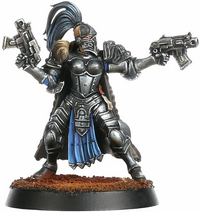
Exclusive to the Sisters of Silence, this is what the Null-ladies get to wear after finishing their training. The Vratine Armour is the armour of oath, containing designs akin to Space Marine Power Armour and possibly a local pattern from Luna (Selenite void-mail; Selene being a goddess of the Moon in Greek ROMAN GREEK mythology). Considering that the suit does not come environmentally-sealed like how Power Armour usually do (as you can see that the "helmet" is actually a full-faced mask) – though additional gear can be equipped to operate in a hostile environment – this armour that these Sisters wear is possibly the closest thing the Imperium has to the Mark I, which is also a Power Armour pattern that is not sealed.
On the other hand, the Sisters of Silence might have been a later addition to the Imperium over the course of the Great Crusade, and the design elements of the Astartes Power Armor is actually derived from a later pattern such as the standard Mark II, or maybe even up to Mark VI, assuming that the armour, like the Space Marines', has several renditions of itself. This is likely since the Vratine is designed with agility in mind, and the protection factor is also definitely not compromised for that.
As a side note, it doesn't have a noticeable reactor (much like Custodes armour) and is not called "power armour" anywhere in the FW books, but it is later identified as a form of power armour in the 8th Edition Sisters of Silence Codex.
-
Witchseekers in Vratine Armour without the helmet.
-
Vigilator with half-mask.
Dragon Scale Armour

Consider this a catch-all term for any variety of proprietary protection in a given Forge World’s standing army, e.g., Crimson or Praetor armor. Dragon scale armor is basically Mechanicum power armour, commonly used by militant Enginseers of Imperial Guard and Myrmidon warrior priests of the Ordo Secutor. It does not have an external power source, as it derives power from your not-so-standard-issue Mechanicus potentia coil (and therefore cannot be used by anyone outside the tech-priesthood or high-ranking Skitarii). As such, it is more accurate to call it an augmentation than true 'armour'.
Not as thick as Astartes power armour, it sports many more inbuilt devices and sensors and gets further pimped by the Techpriest wearing it as he progresses through the ranks of the Adeptus Mechanicus to the point where it's hard to tell where the armour ends and its wearer begins. It is in some ways, similar to Iron Man's armor, but more steampunk. Some wonder if it is connected to the Void Dragon.
Each set of dragon scale is individually hand-forged from adamantine and ceramite plating depending on how much the Adept likes his style, and are woven with prayers of permanence and micro-etched with fractal incantations of defence. In a sense, Dragon Scale Armour provides a higher form of customizability and versatility due to the wearer's vast and extensive augmentations.
So if the wearer wants to be more agile, thinner pieces are used to offer lighter weight whilst implementing stronger servo-muscles for quick bursts of speed; if he/she wants to be a walking tank then the opposite happens as they are bulked up in thicker plates whilst the muscles are reinforced to provide durability and strength.
-
Myrmidon Secutor -
Myrmidon Destroyer
Squat Power Armour
Exo-Armour

Our SPEHSS DORFS too, have their own power armour.
The humorously egg-shaped Exo-Armour is a type of heavy armour, comparable to Terminator Armour, used by the Squats. It is built by the Squat Engineers Guild. The extensive protection it provides is especially useful when fighting in confined spaces where movement is restricted and it is difficult to avoid concentrated enemy fire. Exo-armour is thus greatly valued by Squats, who often find themselves in combat in subterranean tunnels.
Exo-armour also serves as an all-enclosing hostile environment suit. The development of Exo-armour was spurred by the inhospitable nature common to the Squat homeworlds.
Exo-armour incorporates an integrated power axe and boltgun. Squat armourers are adept at forging magnificent exo armour, embellished with the visage of a Squat Ancestor Spirit. The armour is handed down from father to son and is probably the proudest symbols of status of the Squat military aristocracy.
The standard weapons fitted into suits of exo-armour are often upgraded to heavy or combi-weapons by wealthy Squat warriors. They are almost exclusively worn by the elite Hearthguards, although wealthy or prominent Squats such as Warlords and Living Ancestors are known to wear one too.
Space Marine Power Armour
The most iconic users of power armour in 40k are the Space Marines and the Chaos Space Marines. Made of ceramite layers upon plates of plasteel and adamantium/adamantite which will deflect all but the most powerful of weapons, Power Armour possess many life support systems designed to keep the Space Marine inside alive, even in the worst and most extreme of battlefield conditions. Has physical properties that has lead some material scientists (who clearly also do Warhammer) to speculate whether Space Marine armour is in fact an extraordinarily tough ceramic compound (ignoring all this easily trademarkable sci-fi bullshit about plasteel and adamantium/tite), which would make sense given that the Emperor actually invented very little new stuff when making the Marines' battle gear, instead just scaling up and making it bigger/louder/harder/better/faster/stronger etc.
The Black Carapace, one of the Gene-Seed organs, is specially designed to allow a space marine to interface his nervous system with his armour and is the last organ implanted in Codex Chapters. Amongst its features, power armour possess auto-senses to supplement the Marine's already considerable senses, auspex arrays to create minimaps and transmit data between squad members and commanders, painkiller delivery systems in the event of severe bodily damage, and waste recyclers to keep the Marine going for up to fifty days without fresh food or water. Or, for that matter, taking a shit. The connection between the two being one of the rather less dignified aspects of Astartesdom. The power source is a backpack mounted generator which needs initializing, but after that can take solar energy to keep itself going. According to GW, the backpacks themselves were inspired by the bedrolls (actually greatcoats in reality) carried by soldiers in the Napoleonic era. The "roll" on the backpack contains oxygen for use whenever the environment demands (like space combat) and the balls on the sides are either jet engines for manoeuvring in space or heat vents. Some early art showed they are more likely jet engines, and can lift a Space Marine for extra battlefield maneuverability, though presumably nowhere near as good as a Jump Pack. Running throughout the suit is a notoriously wilful machine spirit that maintains the armour and assists with the interfaces.
There are eight ten (technically nine because one has never been shown) types or Marks of Power Armour used by the Astartes. Regardless of their type, they all have massive Pauldrons, under which the Marine's ammunition is stored. Pictures can be found in the gallery at the bottom of the page.
Mark I: Thunder Armour

The first type of Power Armour was designed for the Thunder Warriors and worn by many of the techno-barbarians of Terra. They provided basic protection against weapons and enhancements to upper-body strength, but that is all - the suit was incapable of supporting its own weight and basic variant did not provide any significant protection to the legs. Which seems like a bizarre and terrible idea given that as any person who moves furniture often can tell you; you should do most of your lifting with your legs unless you want to give yourself a hernia, and as most soldiers can tell you, having to carry a lot of extra gear with the weight distributed onto your shoulders sucks and is exhausting, and being fatigued significantly hurts combat effectiveness. But perhaps this was intentional as the Emperor intended to replace the Thunder Warriors anyway. Since they were only used on Terra, there was no need to protect them against the void. Though the lack of life support systems and much lesser degree of protection make them essentially useless in the 41st millennium (this doesn't seem to stop people from pestering Forge World to make models for it though, even though they've said that they won't for exactly this reason), several Chapters retain sets of Thunder Armour for ceremonial purposes. If you were to field one now, it would probably count as carapace armour (4+ save) with a slight bonus to strength but a penalty to initiative.
In Deathwatch, you can actually get your hands on some. Be forewarned: it's noisy, doesn't offer as much protection, doesn't work with a Marine's Black Carapace, and actually might not be a whole suit of armour depending on its state of (dis)repair. Overall, it's kind of shitty, but it's a surviving artifact linked to the days of the living Emperor and early Imperium, and that impresses other Marines and those Ecclesiarchy schlubs. Take it for formal occasions.
Mark II: Crusade Armour
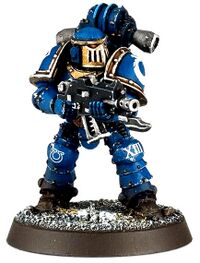
Designed by the Adeptus Mechanicus with the Great Crusade in mind, the Mark II armour was fully enclosed and contained all the life support and auxiliary systems now common among Astartes power armour, like a waste recycling unit and automated medical equipment. Much of these newer additions were made possible by a more efficient cooling system, which allowed a considerable reduction in the size of the power pack. For example, the chest coils, which were kept on the outside of the armour plating on Mark 1 armour for cooling purposes, have now been placed on the inside of the chest plates, so that they are better protected, thanks to more efficient cooling mechanisms. However, this design could not be copied over to the new powered leg armour, which resulted in exposed cabling on the backs of the lower legs.
The helmet also came with a bunch of enhanced sensory equipment, with the wearer is also able to see in the infra-red and ultra-violet spectrums, images can be zoomed in and magnified while noises can be enhanced. Overall protection and flexibility was much improved, especially since the legs were now enclosed in armoured hoops and came with their own servomotor, although with the caveat that the overlapping hooped armour plates being difficult to repair. Unlike the Mark I suit, the design is still sufficiently sound to remain in active, albeit extremely limited, use well into the 41st millennium.
Early depictions of this armour often featured a fixed helmet, similar to old-school diving suits. While Forge World completely retconned this away for the sake of compatibility with other Marine kits, there had been depictions of Mark II suits with movable helmets since the Rogue Trader days, so it's not like GW were ever consistent about it anyway.
-
-
Older version of the armour
-
-
The armour that carried out the Great Crusade
Mark III: Iron Armour
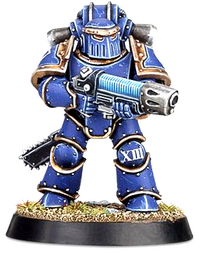
Mark III armour was first conceived for the Squat campaigns boarding actions of the Great Crusade. It was pretty much a modified Mark II designed to provide better frontal protection for close-quarters combat, essentially fulfilling the same role that Terminator armour would later fulfil. It should be noted that the Mark III was never intended to replace the previous Mark but to act as an optional suit specialised for the above-aforementioned situations. Because of this, no Legion was ever fully equipped with the Mark III. While successful in the conditions it was designed for, the armour was too clumsy and uncomfortable for conventional fighting.
By the time of the Horus Heresy, the Mark III was slowly being phased out and replaced by Terminator armour, but it's still fairly common among the Traitor Legions. In fact, several of the more traditional Legions were reluctant to phase out Mark III because it was the most brutally iconic mark of power armour in their day, so there was talk of keeping it for honour guards or spear tip operations.
Of course, since it was good enough that it did Terminator armour's job well enough to become "iconic" despite the Mark II being the primary issue at the time, then maybe they should've kept using it to augment Terminator forces when numbers were needed. Even into M41, the helmet or faceplate is still popular. It appears as a DLC armour in The Last Stand for the Space Marine Captain, where it increases the force of his melee strikes.
-
-
-
-
Heresy era Emperor's Children legionnaire -
Ultramarines
Mark IV: Maximus Armour
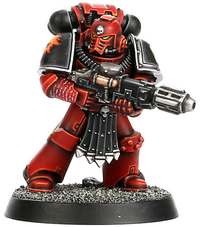
Now having access to more Standard Template Constructs, the Mechanicum was able to further refine power armour internal systems. In addition to having more advanced visual sensors, the helmet was now capable of easier movement. The suit was also made a whole lot lighter than before while only marginally reducing Mark II's protective capabilities. Bears mentioning it had much, much more superior manufacturability compared to MkII and was easier to repair due to its nature of having no interlocking armour plates and whatnot.
Although the chest power cables were once again relocated to the outside of the plating, they were given an armoured sheath to protect them from damage (since the gaps between armour are actually made of plasteel, that was likely used on the cables, as plasteel gives Terminator armour its legendary durability). Horus Lupercal manipulated the Mechanicum's supply lines to ensure that the Legions that were planning to side with him in the Heresy would be fully equipped with Maximus Armour in time for the Heresy; as a result of this, Mark IV was usually reserved for Chapter Masters and senior Captains of the Loyalist Legions. As the Legions were either fully or partially re-equipped with these suits by the time the Horus Heresy began, Mark IV is one of the most prevalent types of armour among the Chaos Space Marines.
It's a little strange that the Imperium didn't build more of them after the Horus Heresy, though, since it's far easier to produce and repair than the current Mark VII but not notably inferior. Seeing as they're always short on everything, you'd think these features would be the most important thing to consider for them (Apparently the Red Scorpions and Iron Hands are the only loyal chapters who still know how to produce them, and presumably won't share the STC for the same reason the Blood Angels won't tell people how to put Librarians into Dreadnoughts).
Some Chapters/Legions also made their own sub-patterns of Maximus power armour, such as the Ultramarines' Praetor pattern and the Thousand Sons' Achean pattern.
-
-
-
-
As a relic of the Angels Revenant chapter -
Tactical Squad
Mark V: Heresy Armour

In between production of the Mark IV and what would be the Mark VI, both Loyalist and Traitor Legions found that they were running out of replacement parts for damaged systems. This would result in several Legions taking parts from older Marks and inadvertently making a brand new Mark of Power Armour. Although appearances varied widely as a result of its ad hoc nature, some form of standardization was achieved. One of the most notable was the introduction of molecular bonding studs on the left pauldron and both greaves (the famous "rivets"), which made them look totally Metal - these were actually originally designed to field-patch busted vehicle armour before they could be repaired properly. Probably one of the most common suits of armour in service among the Traitor Legions, since this was what most of them were wearing when they retreated to the Eye of Terror.
For a while, the Horus Heresy novels and black books outright retconned Mark V armour into a catch-all term for any improvised or prototype suits that existed outside of the main Mark series, yet weren't advanced enough to be considered artificer armour (likely so Forge World wouldn't get nagged to make variants of all their Mark III and IV squads in Mark V as well). However, they ended up backpedalling on this a bit in Retribution. The classic "studs and cables" version shown here is now apparently considered the "production" model of Mark V armour (presumably an Adeptus Mechanicus-sanctioned version that went into mass production), while the more variable, improvised suits it was based on are "non-production" models. Presumably, Forge World realised that the retcon didn't make much sense, since all known art and models of the armour up to that point were no less visually consistent than any of the other Marks (and arguably more consistent than a couple of them).
-
-
-
-
The Carcharodons favourite armour pattern
Mark VI: Corvus Armour
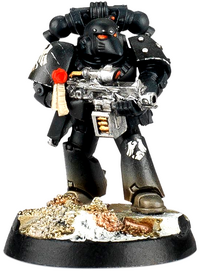
The much-beloved Beakie armour. Designed during the latter years of Great Crusade, this one was initially field-tested by Salamanders and Iron Warriors to become a proper Mk V. While the former's reaction is unknown, Perturabo despised the idea of reducing the protection of his cannon fodder sons. He arranged the next test to be conducted by the Raven Guard, and so Corax, whose tactics Perturabo despised, received a lot of Mk VIs and was sent on the galactic fringe to fight Eldar. To Iron Lord's surprise, the test was such a smashing success that the suit received the XIXth Primarch's name, and Beakie armour became a common sight in his legion even before it was actually accepted for service in wider Imperium. It anticipated some of the lately developed Mark VII features, producing a suit of armour that is in many ways equal to its descendants, if being a little bit specialized.
Although it offered the worst protection compared to all other proper marks, Mark VI armour was the first to feature a redundant power system and parts that are largely interchangeable with those of other marks, particularly with Mark VII. Somehow, it also manages to be lighter and fit together more smoothly than the current Mark VII Aquila, allowing for quieter movement, while the helmet includes further improved sensor systems in its, um, "beak". Due to the design's inherent stealthiness and legacy, it still remains the preferred armour among the sons of Corax, who tend to be saddled with older equipment anyhow. For reasons nobody can seem to explain, it was also sporadically used by the Alpha Legion around the time of the Horus Heresy even though it was never actually issued to them. Then again, it's the Alpha Legion so who knows.
-
-
-
-
A White Scars legion tactical marine -
Mark VII: Aquila/Imperator Armour

You know'em, you love'em. The most iconic Power Armor design in the franchise and also the Mark that has been in production the longest. Whilst other older Marks (With the exception of the Beakie Armour) was eventually phased out in the two centuries of the Great Crusade and Horus Heresy, the Mark VII chugged along for 10,000 years because the AdMech hit a Derp and couldn't be assed to make a new Mark until the return of Papa Smurf. Those lazy fucks. (Or more realistically, the Mechanicus didn't see enough significant reasons to replace the Mark 7, who was already pretty good as is. Extensive R&D, re-tooling entire Forgeworlds to meet new demand, and retrofitting existing suits with new parts aren't cheap, and that's on top of their 'Innovation is the Devil!' dogma.)
The most common Mark of Power Armour among loyalist Space Marines, Mark VII armour was still being designed when the Traitor Legions reached the Sol System and seized Mars. When this fact became all too foreseeable, Rogal Dorn ordered the design teams transferred to Terra to prevent the Traitors from seizing it. Mark VII featured completely covered chest and arm cabling, a distinct helmet that provided more protection, a high level of compatibility with previous Marks, and also bore the Imperial Aquila on the chest, which was first used there to provide quick identification of the Loyalist Marines during the chaos of the Siege of Terra.
Moreover, this Mark abandons the studded shoulder armour plate and replaces the helmet. As Mark 7 is a development of Mark 6, both have a great deal in common, and parts from one Mark are readily interchangeable with parts from the other, like the helmet. According to GeeDubs, the design of the helmet was meant to resemble a human skull, but you must be drunk from Mjord in order to see that resemblance. The Mark VII also contains its own back-up power supply and a solar array to recharge this, so the suit can operate even without its backpack though only a short time.
-
-
-
The most iconic pattern
Mark VIII: Errant Armour

Jes Goodwin originally designed it with awesome Power Fist-style hands, a modified helmet, a streamlined power pack, and a more flexible leg-and-ankle joint. Games Workshop only bothered with using the altered breastplate, so the overall design looks like a regular Mark VII with a collar. That said, the more recent models for Space Marine Devastators have a flexible, ball-like ankle joint more in line with the original artwork. Deathwatch models have this ball-joint and the modified helmet, and Primaris models also have this ankle joint, presumably inspired by the Mk VIII like the breastplate collar is. Said collar is described as being brought into use due to an alarming pattern being noticed; namely, that bullets would deflect off the top of the breastplate and up into the bottom of the marine's helmet, killing him, or would pass in-between the bottom of the helmet and the top of the chest plate, into the marine's throat, killing him (similar to a problem found on the gun mantlet of Nazi Germany's Panzer V Panther D & A tanks in WW2, in which the rounded mantlet would send shells straight into the hull roof. Later Panther G models would have a "chin" to prevent this).
This was only really a problem with bolt shells due to plasteel armour protecting joints. But, when most of your enemies use bolts of some size or against Traitor Marines, this is really damn bad. Breaking the trend of reverse-compatibility between newer and older marks, this Mark can only accommodate the helmet designed for it, which kind of becomes a moot point when reserving it for officers, since everyone higher up than a Battle-Brother will never wear his helmet. The specialist design, or the Adeptus Mechanicus's head-up-own-arse tendencies around distributing new technology are thought to be the probable reasons why it has yet to be widely adopted among Space Marine chapters. Because of its rarity, the armour is generally restricted for use by senior officers only, and even then they'll usually only be able to wear the breastplate. The Munitorium series from GW, however, shows that it's fully compatible with Mk7, so Veterans will sometimes receive a part of Mk8 to replace analogue from their Mk7 for some heroic deed, meaning if some Veteran is equipped with full Errant pattern, he is a serious badass and likely expects promotion. The Minotaurs and Deathwatch chapters appear to be the exceptions here, as almost all of their Battle-Brothers have access to full suits, the former because they suck the High Lords' dicks and the latter because the Deathwatch is a special operations group made up of veterans of all chapters.
It should be noted that, while Artificer armour (at least in the art) looks like a pimped out Mk.VIII, regular Mk.VIII doesn't actually improve armour save. But Fantasy Flight gave it some love with an extra armour point all around, and the ability to deflect some headshots to the chest, greatly improving its protection and explained why so many officers using it tend to not wear a helmet (not to mention that the collar helps protect the neck from shrapnel or shots hitting it).
-
-
The Errant Armour comes as a standard...
-
in the Deathwatch, apparently...
-
The most complete depiction in official artwork to date
Mark IX Armour
Suffered the same fate as Windows 9. Who knows, really. This mark was skipped over when Mk10 was introduced, and no details were made available. It could either be an Mk5 treatment, with any Mk7 or 8 suits made with improvised parts or even contemporary Artificer Armour counted as the Mk9. Another possibility is that the Mk9 might be part of Guilliman's new job of actually getting stuff done and gets a new mark rolled out for the Classic Marines. Nothing's really known at this point, and there's still no word over three years after Primaris were announced. Why GW don't make a new set of models and saying that this Mark is used to bring Veteran Marines physical capabilities to Primaris level is a mystery for the ages. Then again, it could just be that Mk 10 sounds way cooler than Mk 9 (iPhone X and Windows 10, anyone?), although Geedubs did allude to its existence when Primaris armour was revealed to be numbered as 10.
If it helps, it has been suggested in forums and such, that Mark 9 power armour was that 'variant' which was used by pre-Primaris Librarians. Still, it is annoying that nothing official is there to be found. This could, of course, be nothing more than wishful thinking or plain old nonsense, as Librarians have been shown in various armour Marks, and some sources have shown their psychic hoods as a detachable add-ons rather than built-in.
Mark X Armour System
A new form of Power Armor introduced in 8th Edition, worn primarily by the Primaris. Unlike all previous marks, the Mk. X was built with internal modularity in mind, and all their pieces can be swapped into another that make a single set or armour change its battlefield role. If the next mission is more stealth oriented, you don't need to ask for a new armour, just change the pieces into the ones of the Phobos; or if you're going to take heat, change it into a Gravis. It's basically kitbashing on an armour level. But this also lets you to create your own armour configurations.
There are several configurations that are currently in use:
Tacticus
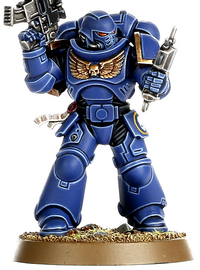
The "default" form of the Mark X, the Tacticus configuration combines aspects of previous armour patterns, such as the Mk8 collar and the Mk4 helmet being the obvious bits, and all the latest technology of the Imperium in the 42nd Millennium. (Still doesn't affect armour save.)
So far it's only been shown on the Primaris Space Marines, it is unknown if the scruffy old obsolete Space Marines will get it. The vambraces are noted to have built-in cogitator systems, which can be used for a variety of purposes depending on the user's role, whereas the knee plates have its guard raised, protecting the joints. Other improvements include the Pauldrons which now incorporate a second armour layer, reactive armour and curvature which increases the armour's protection potential as well as a reinforced undersuit. Moreover, the armour also has socket ports for stim-injectors and diagnostic data-links, which makes the life of an Apothecary a whole load more easier.
On the other hand, the MkX backpack now has reinforced armour plates which offer better protection to the vulnerable fusion reactor. Like all MkX armour the Tacticus class is highly customizable, for example, the librarian has a Gravis style plated belly. Other changes can be seen across the range, such as the form-fitting greaves on the Chaplain, and the occasional addition of tassets to the hips (especially common on Hellblasters).
Due to the modular system of ceramite plating, maintenance cost is actually higher than older Marks of Power Armour. That and it's bigger too, which means more material cost on average (Although the high customization actually cheapens the overall cost of a Chapter's armoury due to the increased standardisation).
-
Primaris Apothecary -
Primaris Chaplain -
Primaris Librarian.
Gravis

The heavy configuration, the equivalent of Terminator Armour that grants +1 Toughness and +1 Wound as well as more mobility and flexibility. Yay. (Rumours that 8th Edition was being designed to make future video projects easier to code remain unfounded.)
Gravis armour is worn by the Captain included in the Warhammer 8th Edition Boxed Set. The example captain had both a master crafted power sword (that does two wounds nowadays) AND a brand new Boltstorm Gauntlet which combines the functionality of a power fist with a bolt pistol capable of firing at triple rate -- Marneus Calgar approves. Said armour design appears to take some leanings from... Iron Man (a noted early proponent for the founding of the Mechanicus, as such a most blessed servant of the Omnissiah), or perhaps the T'a *BLAM* HERESY!, or Terminators, with what appears to be augments on the legs, an enhanced ribcage, and an enclosed armoured hoodie for good measure.
Gravis Armour (like all Mk. X) is highly variable; for example the Inceptors have a Tacticus-style bodyplate and a retractable face-shield.
Gravis Armour is also worn by the Inceptor Squads, granting them the toughness boost as well. Their version also comes with built-in jump packs, replacing the normal backpack-worn type, and shutter style face visors. Another variant is worn by Aggressor Squads, which can come with Fragstorm Grenade Launchers.
Models in Gravis Armour are fucking big even compared to even the NuMarines, so... Primaris Centurion Armor.
Seems to be the most contentious of all the Mark X variants, by far. It really seems like you either love or hate this one.
-
Primaris Aggressor -
Primaris Inceptor
Phobos

Another Mark X configuration worn by Reivers, Vanguard Lieutenants, and Incursor Primaris forces, the Phobos can be compared to the Mark VI Corvus Armour due to similar associations with recon troops.
Like the Mark VI, the armour is designed for silent infiltrations and drop assaults – and by "drop," it is sneakily by Grav-chutes, and not flashy like Jump Packs – and in the same way the older mark was pioneered by the Raven Guard, Phobos Armour was pioneered by the Primaris Reivers. Since Reivers from time to time enter the battlefield via air drop, the armour's power pack sometimes sports a pair of fins for the occasion. These fins are used to direct flight as the Reivers' Grav-chutes slow their descent. Whether or not those fins are the Grav-chutes themselves is arguable – probably unlikely because aside from Digital Weapons, Imperium tech does not shine really bright in the field of miniaturization; that is to say, their style choices usually go big or go home. Most of the Vanguard Marines seem to lack these fins, which supports the assumption that they're not the Grav-chutes themselves (Actually, only the Lieutenant in Phobos Armour has the Grav-Chutes ability out of the Vanguard, and he has the fins. Other Vanguard are just sneaky, and have Concealed Position instead). The Infiltrators' power packs instead sport a bunch of antennas, which make up an omni-scrambler system designed to conceal them from enemy auspex scans, while Incursors instead have a visor system mounted, allowing them to see through any obstructions to their sight.
The standard Phobos helmet seems to come in a couple of different shapes, which resemble either a Mk X Tacitus helmet or a Mk 7 helmet (both of which sport what seem to be some kind of rebreather system). The Reivers instead rock a Night Lords inspired skull-helmet instead of a Raven Guard Beakie, which may or may not be awesome, and it amps up their voice to insane levels of sound.
-
Mask-only Style -
Grav-chute Fins -
Incursor
Omnis

Worn by Vanguard Suppressor Squads. It's basically just Tacticus configuration with Inceptor shock absorber boots, Reiver-style Grav-chutes and gorget/collar, a miniaturised jump pack (which looks like a second pair of backpack exhausts with little tail stabilisers), and a new helmet visor design. May or may not offer a middle road between the Gravis and Tacticus configuration in terms of defence.
On the whole, the Omnis is lighter than the standard Gravis configuration due to the implementation of the above equipment. Of course, how it is made lighter, we do not know, as unless these armour pieces are intentionally made of a different material or structured differently, they look exactly the same as the rest of its contemporaries.
The models have been the subject of a fair bit of "debate" since their debut in the Shadowspear box, although that's likely got little to do with the armour they're wearing, and more to do with those ridiculously oversized accelerator autocannons that they're toting.
-
Vanguard Suppressors in Omnis.
Artificer Armour

Pimped out and individualized versions of regular suits, often enough to be considered one-off derivations in their own right. Artificer Armour can be formed from any older mark of Power Armour (perhaps barring Mk.I plate possibly excepting Thunder Warrior officers) by adding extra or upgraded protection. The upgraded and individualized suits mean that they require a lot of maintenance and needs techs to work around the clock to make sure they stay functional. In time suits become encrusted with unique decorations and individual upgrades and becomes known as Artificer Armour. Because of these heavy modifications, Artificer Armour is often highly superior to newer suits of standard-issue Power Armour, and afford much better protection.
So in simple terms, the more blinged-out the armour, the better it is stat-wise. With little to no standardisation, meaning that no two Artificer Armours are the same, design-wise. Standard issue for Techmarines, the Sanguinary Guard and optional for officers, pairing Artificer Armour with an Iron Halo can offer better protection than Terminator armour with none of the drawbacks, yet with only some of the benefits.
During the Great Crusade and Horus Heresy Space Marine Sergeants, the various Honour Guards (if they don't have the option of Terminator Armour) and even unaugmented officers of the Solar Auxilia could go into battle wearing Artificer Armor. Just another example in a long list that shows how the Imperium is a shadow of its former self. Yes, this means that every squad in 30k tabletop can have someone with a 2+ save in the pre-8th edition armor rules. Yes, it is hell.
-
Techmarine
Aegis Armour

The Power Armour of the Grey Knights, Aegis Armour is master-crafted on the forges of Titan and inscribed with prayers and wards to prevent Daemons from possessing it. Early fluff insinuated that several psykers were burned alive to be sacrificed as part of the machine-spirit of the armour, but this aspect has been downplayed massively in later revisions. (Considering the Golden Throne burns an ungodly number of psykers every day to keep Him alive, this isn't too farfetched; opinions nonetheless vary on whether this is true, and if so, whether it is Grimdark or Grimderp.)
Based on parts from Marks VI, VII, and VIII, within the breastplate of each set is a copy of the Liber Daemonica. It frequently bears a Stormbolter on its left forearm, keeping both hands of the wearer free to use. There is an Aegis/Grey Knight version of Terminator and Dreadnought armours, too. Just remember to keep any observations that Aegis Armour look in anyway similar to Tau Battlesuits to yourself.(But it isn’t made of paper.)
Could also be the aforementioned Mark 9, since the Inquisition scrubbing it from records if that were the case would explain why we know “nothing” about it.
-
Variant 1 -
Variant 2
Auramite Armour

The most common power armour within the Adeptus Custodes, it is straight up in the top 3 power armours of the Imperium, its other contenders being the Aquilon & Allarus Terminator armours. The material used for its construction is known as, you guessed right, Auramite (which is ceramite, except even better): The first samples and tech to make it was brought back from the depths of Terra. Another interesting fact is that the servos and motors of the Custodes armour are nearly completely silent. Turning a Custodes into a sneaky marine. A very shiny sneaky marine.
Custodes power armour also includes a built-in Grav-chute and internal air supply (But let's be honest, the Grav-chute is all but pointless since we never see it...well...anywhere). Each suit's helmet includes an internal vox, an altimeter, ambient neutralisers, and hololithic schematic overlay map.
The armour itself is even better than Artificer armour and includes a refractor field, essentially giving it the same properties in-game as Terminator armour. It can even get a teleportation transponder as well as an Arae-shrike: a nasty (so nasty the Mechanicum declared it blasphemous) piece of archeotech that fucks up nearby cogitators. The only ones allowed to make it, like all Custodes-grade weapons, are Emperor-chosen clans of Terra. Probably the only people the Mechanicus won't fuck with for fear of the golden bois getting...inconvenienced.
-
Sagittarum Guard -
Shield Captain -
Custodian Warden
Terminator Armour
Terminator armor, or Tactical Dreadnought armor, are set aside for space marine veterans who are exemplars of toughness, martial ability, and wonky proportions. This power armor provides the best personal protection available. Terminator suits have an outer shell of ceramite-bonded plates powered by electrically-motivated fibre bundles. Plates of heavy plasteel further armour the ceramite sections, especially on the front of the suit. This extra armouring provides a level of protection that is far superior to normal Marine armour; not even a Krak missile will penetrate the suit's breastplate (Which one wonders why Imperial tanks aren't coated with this stuff (cost/supply=/=demand). Moreover, external adamantium layered ribs help support this weight, while the inclusion of suspensors help the suit carry heavier support weapons, not to mention those indestructible pauldrons, a suit of Terminator armor is built to steamroll nearly everything and gives a fighting chance against everything else, which are the things that gives anybody else a fighting chance against Terminators. Standard loadout for Terminators are power fists and storm bolters, or Power weapons and twin linked bolters for the Chaos Terminators; but these are often and changed up with other heavy weapons systems, other killtastic melee weapons, and a squad is sometimes augmented with a shoulder-mounted missile racks. Since most suits are about at least as old as the chapter that owns them, and that the pauldron allegedly contains a tiny fragment of the Emperor's own power armor, these suits are holy relics as well as top shelf wargear.
Despite all the pain they lay down (and keep away), Terminator armor has a few serious drawbacks. First thing is that it is seriously hard to make. Seriously. Most chapters have only a handful that they can distribute amongst their veterans and officers, and any lost suits are damn near impossible to replace. Second thing is that they lack mobility. They counter this mostly since Terminator armor can be safely teleported from orbit into the thick of it, and judicious use of teleport homers can put them right where you need them, and a heavy transport such as a Land Raider can carry small squads. Beyond that, Terminators are otherwise going to be footslogging since they're too fucking huge to hitch a ride on anything smaller than a house. Better plan on not moving them too far once they hit the ground.
There are other patterns mentioned in the fluff but not yet seen on the tabletop, or available elsewhere in such small numbers they can be counted as unique variants.
The Minotaurs have widespread access to a rare type of Terminator armour, known as the Arkonak Pattern. However, every official illustration of a Minotaurs Terminator to date has them wearing either Indomitus or Tartaros armour, including their Chapter Master (the original Tartaros Terminator model).
The First Legion's Ironwing supposedly owned the greatest concentration of Terminator suits out of any of the First Founding Legions, and included a number (plural) of experimental patterns that were unknown anywhere else. Though Forge World neglected to describe or provide rules for any of them. So as far as we know they are just functionally identical suits of normal terminator armour that come in different shapes and colours.
Whereas Extermination claims the Alpha Legion used five patterns of Terminator armour during the Invasion of Paramar, suggesting that other patterns are yet to be revealed. Or, you know, the Alpha Legion being what it is could mean that their in house artificers are straight up inventing new technology or their infiltrators were stealing technology from other Legions.
Nevertheless, Terminator Armor has 3 major designs: the Cataphractii pattern, the Tartaros pattern, and the Indomitus pattern. As well as a few more lesser known but still prominent designs. More of which can be read below.
Cataphractii Pattern Terminator Armour

The oldest design bar a few prototypes and the first pattern to enter mass-production, developed during the Great Crusade and based on fusion-reactor maintenance suits. The Cataphractii pattern had Roman-esque, slab-like pauldrons (which apparently held shield generators), which enabled greater protection at the cost of preventing the wearer from moving with any sort of speed. It was the Mechanicus' intention to retrofit all 18 Legions down to the last Marine with Terminator armor at first, but it proved to be unfeasible as crafting those required far too many resources. In the end they were adopted for use in those situations where even Breacher squads struggled yet heavy ordnance was too difficult to deploy, typically boarding actions but not only.
After the Horus Heresy, Cataphractii pattern had eventually fallen out of general use. This may have been because the last of that armor was either lost in the fighting and the pattern became another lost technology in the following years. Or because production was ceased in favor of later patterns, and most suits were either cannibalized or became a relic that was the chapter's equivalent of fine china: makes a nice display piece, but practically useless due to enforced disuse. These relics wouldn't see field use again until the day GW released the Angels of Death supplement (no doubt because they'd sell more copies of Betrayal at Calth if both 30K and 40K Marine players could use it).
In crunch terms, this translates to a higher invulnerable save than the Indominus/Tartaros armor at the expense of losing the abilities make run moves or overwatch. In 8th edition, Cataphractii have reduced movement compared to the other versions as well as halved advanced distances, but get a couple alternate weapon options and retain their boosted invulnerable saves.
9E combined Cataphractii and Tartaros Terminators into a joint datasheet called Relic Terminators. While this bumps Cataphractii terminators up to a more standard 5" movement, it also drops their invuln save back down to a standard Terminator invuln save. They have a much more specialized loadout than regular terminators, so if you are looking for a more ranged variant of terminators, you'll probably want to look elsewhere.
-
Pict Captures -
Ultramarines -
Word Bearers -
Imperial Fists
Tartaros Pattern Terminator Armour
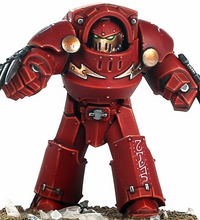
The Hulk Suit.
The most advanced pattern, using systems developed for the Mark IV "Maximus"-pattern powered armor. Tartaros Armor delivers the same level of protection as the Indomitus pattern but is much more mobile, with sensibly-sized pauldrons and an upright stance. Due to the advances in Pauldron Technology, Terminator Squads in Tartaros Armor can Sweeping Advance, unlike the others encased lesser models. It is however the rarest of models, since it was a very resource-unfriendly model to craft back at the time of the Heresy. In the 41st Millenium, any remaining Tartaros-pattern suit is a hallowed relic for whoever is lucky to still have one in functioning order.
In 8E's crunch, Tartaros Terminators move at the same speed as regular infantry in Power Armor (Which is pretty dang important if you're set up like an Assault Terminator) and also get a couple alternate weapon options, such as a grenade launcher and a Volkite Charger.
9E rolled Tartaros and Caraphractii terminators into a single datasheet referred to as Relic Terminators. Functionally, they're identical to the standard Terminator Squad with a minor difference in loadout options, namely the ability to take Plasma Blasters on their sergeants. Kind of a shitty fate for a unique set of models when GW is more than willing to make separate datasheets for every conceivable Primaris Marine they crap out.
-
Pict Capture -
Ultramarines -
Thousand Sons
Indomitus Pattern Terminator Armour

The Indomitus Pattern is the current pattern of Terminator armor (though the Forge World books make it clear that it was common at the time of the Heresy, perhaps more so than Tartaros and Cataphractii), sharing similarities with the Tartaros pattern in terms of functionality whilst being cheaper to manufacture.
As a later development that sacrificed a little protection for increased mobility and was (comparatively) easier to produce as previously mentioned, this was considered the Indomitus pattern go-to marketing ploy. This is the most commonly produced pattern, as Cataphractii armour was said to be in declining use due to its limitations and Tartaros armour was even more resource intensive to craft, placing Indomitus in a comfortable medium of "good enough". It has the familiar hunchbacked-bulldog/horse appearance, as seen in the majority of Games Workshop Terminator kits (although they now produce plastic kits for the other major patterns too).
Though inferior to the Cataphractii pattern in protection, and inferior to Tartaros pattern in mobility, the Indomitus pattern has quite advanced auto-sense systems that are unavailable in normal suits of power armour, and have not been entirely made evident from portrayals of the other types. These senses allow the user to track unseen targets and to know the precise location and condition of their squadmates at all times (while this is evident in the video games as a passive mechanic it can't really come up on the tabletop since the player sees everything anyway [except for "blips" in Space Hulk]). But these systems are noted in the RPG and various novels such as Master of Sanctity where the new user has to get used to a whole new suite of tactical information on top of actually learning how just to walk in the armour itself (hint: it's difficult).
A more interesting note is that this pattern also gave rise to the experimental Gorgon pattern (More of which can be read below), a design that was being tested during the Heresy by the Iron Hands Legion. There are also human-sized suits of Terminator armor, but the tiny amount of them that still exist are used exclusively by the Inquisition; even then, they aren't quite as potent as the versions used by Space Marines, due to lacking a Black Carapace.
-
The Deathwing is here. And it's very angry. -
Ultramarines -
Close Combat -
Blood Angels
Gorgon Pattern Terminator Armour

The aforementioned armour set. The Iron Hands also developed their own variant on the Indomitus armour, called the Gorgon Pattern. This armour was bonded to its wearer in a painful cybernetic connection, so he could never remove it (Kind of like a loyalist Fleshmetal Armour), but also meant he was even more resistant to injury, and it had a unique field effect that caused blinding bright flashes whenever it was struck.
Part of the reason why this armour pattern is so cybernetically-intensive is the fact that (Other than stroking the Iron Hands' technophiliac tendencies) the heat and electrochemical toxins bleeding from the suit limited the armour's agility, and its effects required a high level of cybernetic modifications for its wearer to endure.
This pattern is nowhere to be found after the Heresy, likely because Ferrus Manus didn't live long enough to work out the kinks in the design. Although, considering how similar it looks compared to the present Indomitus, it is a possibility that the Iron Hands had a hand in the creation of that pattern, whether as the designers themselves, or some Tech-priests (or Techmarines) managed to acquire the design and tinkered with it to make cheap Terminator Armour that could actually be taken off if needed.
-
Gorgon Pattern alternate view.
Saturnine Pattern Terminator Armour
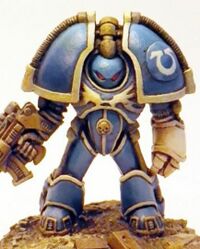
Ah...the much famous egg-shaped Terminator armour which seemed to have been 'gifted' from the Squats Exo-Armour.
This was one of the most incredibly elusive pattern of Terminator armour, called Saturnine. It's got the biggest pauldrons one can get before moving into walkers category and was famous for it's extreme bulk, durability, cumbersomeness and difficulty of piloting - basically everything good and bad about Cataphractii turned to eleven. It never went out of field testing phase, since new smaller Castraferum Dreadnoughts could do everything Saturnine was designed for (boarding actions and indoor/tunnel fighting) better and without it's numerous drawbacks except for needing a half-dead Astartes. Some legions still had their batches of test suits when Horus Heresy hit and used them to gain whatever edge over their opponents they could, but they were never seen after the Heresy.
Nevertheless, the Saturnine pattern has occasionally been given a passing mention in Forge World's Horus Heresy rulebooks from time to time, where it was mentioned as being similar to the Indomitus and Tartaros patterns in function (if not design). However, some people have speculated that it is a revamp of an old Rogue Trader-era version of Terminator armor, as such a suit was recently shown in interior illustrations for the novella Meduson. From the pictures, this pattern looks like it is intended as a heavy fire platform, like a less Xzibit-friendly version of 40K-era Centurion Devastators. Which is awesome. However, this specialisation, and the fact that the armour was described as a custom job devised by Vulkan rather than a general-issue design, goes against it being the Saturnine pattern.
-
Truly old school. -
Note the unique back-mounted weapon attachment. -
Aegis Pattern Terminator Armour
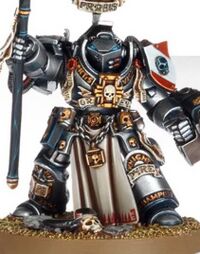
Just as how the Grey Knights have access to the normal Aegis Power Armour, the Silver Sues also gain access to the Aegis Pattern of Terminator armours, where the Aegis part essentially means the armor has its own psychic shield (inscriptions, holy water, all that blessing stuff) to deflect whatever Daemons or Psykers throw at it. Who does it anyway? Psyker Tech-priests? Nah, probably just their Techmarines.
In a sense, the Aegis Terminator Armour functions like a combination of the normal Aegis Power Armour and the Terminator Armour, creating a formidable defensive set piece against the most powerful of Chaos Daemons. These chaps are used when fighting the most clusterfuckery of Chaos invasions up to and including, a certain Daemon Primarch going on his happy murder spree on Armageddon.
They provide one of the best protection out of any armour piece save for the golden boys of course.
In 8th Edition, this pattern of Terminator Armour works like standard. However, with 2CP, you could use its Aegis abillity, which like in the Fluff, can be used in the psychic phase before a friendly GREY KNIGHTS unit attempts to deny the witch. They could then roll 3d6, picking the two highest when attempting to deny. Some Grey Knight veterans are still rather sore this is no longer part of the Special Rules which made them overpowered in 5th Edition.
-
Aegis Pattern alternate view.
Aquilon Pattern Terminator Armour
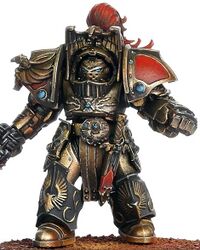
The Adeptus Custodes have Aquilon Terminators which is, no surprise, tied with the Allarus as one of the best armour sets in the Imperium. Period. The Custodes Terminators' armour was said to be Cataphractii pattern in the short story Hands of the Emperor, years before they got actual tabletop rules; this is technically still true (at least for 30K), depending on how you look at it, as Forge World made a point of describing the Aquilon pattern as a spin-off of Cataphractii armour when it debuted in Inferno, but with far greater power capacity and customized neuro-fibre uplinks, it is said, redesigned by the mind of the Emperor himself.
Aquilon Pattern Terminator Armour was said to have adjusted for the enhanced physique of the Custodes, who were capable of bearing more weight and strain than even Space Marines. This allowed it to be fitted with additional power systems and capacitors, increasing its durability and manoeuvrability. Aquilon Pattern Terminators were given more advanced weaponry than their Astartes counterparts, wielding weapons such as Lastrum Storm Bolters, Solerite Power Gauntlets and Power Talons, Infernus Firepikes, and twin-linked Adrathic Destructor. Like their lesser Auramite cousins, the Aquilon was clad in Auramite rather than Ceramite.
Within the ranks of the Custodes, Aquilon Pattern Terminator Armour was deployed by the Tharanatoi Caste.
As expected, it has rules different from (read: better than) the Space Marine version. Much like Tartaros it can fire Overwatch and make Sweeping Advances. As seen from the list of gear above, Aquilons have better stuff than what Astartes of both flavours get.
Allarus Pattern Terminator Armour
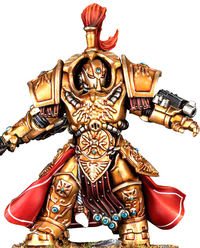
You think the Golden Custards just stopped at the Aquilon? Yeah no, they also have a second pattern called Allarus Terminator Armour for their 40K-era squads, which according to their community lore section on Terminator Armour was made the product of 10k years worth of research and development, and it shows. Lorewise Allarus Terminator Armour has greater durability than normal terminator armour, but none of the downsides, offering total freedom of movement.
Driven by magnatomic generator-shrines, articulated with leonus-class actuators, and fashioned from layered auramite and adamantium, Allarus armour is a marvel of craftsmanship. It provides its wearer with an exceptional range of movement and near-unencumbered speed, augmented strength and resilience. According to GW, it has the survivability to stride unharmed from the blast of a Macrocannon shell. Which we call Bullshit on that claim, since even the small ones from an Aquila Strongpoint is launching Schwerer Gustav-sized shells, no way in hell that the armour set, let alone the Custodes himself is capable of surviving a direct impact from that, so we could put it as more of GW shitty flowery language and hyperbole.
Going back on topic, the armour is also coupled with the protective blessings of the Emperor, Allarus Terminator plate is arguably the most effective man-portable combat armour in the entire Imperium. These expertly crafted suits are each individually worth entire worlds.
Crunchwise, in 9th Edition, these armour sets gifts the Allarus Terminators with four wounds each and equipped with Balistus Grenade Launchers in addition to their guardian spear/castellan axe...and can deep strike without needing the Stratagem to do so. Ouch. They're designated character killers, with Slayers of Tyrants allowing them to move up to 3" towards the nearest character when piling in and consolidating even if the character isn't the nearest enemy model. On the other hand, a Shield-Captain with the Allarus hass the same stat line but with an extra Wound, nevertheless, you also get the signature Balistus Grenade Launcher and From Golden Light special rule from the Allarus Terminators (for only 10 points more than the vanilla version at 109 points). You lose the Sentinel blade/Storm shield option, but the Eagle's Eye can fill in for it without making you give up any offensive capability. (Here's the humongous golden terminator daddy you've always wanted.)
Centurion Armour

The (in)famous 'Power Armor inside of a Power Armor' set piece.
Since somebody at GW forgot that the Xzibit meme wasn't funny anymore, Space Marines now have centurion armour that they equip like a miniature walker vehicle, more like a mini-mech, a cute little dreadnought preparing space marines for their life after living. Centurion armour is "worn" over regular power armor, giving better protection (like terminator armor without the invul save but with an additional wound, along with +1 to both S and T) and comes in two flavors: assault and devastator. Assault centurions are heavy assault units equipped with drills and meltas or flamers, meant to get in close to enemy strongpoints and fortifications and wreck shit. Devastator units are heavy fire support units with hurricane bolters and twin-linked heavy weapons, which, in practice, provide less fire power than regular Devastator Squads, but higher resilience and mobility, as the suits have Slow and Purposeful.
Fluffwise, the machine spirits on this thing is advanced, almost on par with the Land Raider's. There has been once instance where a group of Salamander Centurions were deployed to clear out a Dark Eldar incursion. The Dark Eldar released a toxin that liquefied people into soup and the marines wearing the armor eventually perished after their suits took damage and the toxin leaked through the cracks. A bit miffed after the loss of their pilots, the Centurion suits' machine spirits continued to fight on, even after their pilots were just fleshy goop at this point. They were eventually disabled, but not before killing scores more Dark Eldar during their rampage.
Paragon Warsuit

For more information, see here: Paragon Warsuit
This derpy piece of contraption is the Sisters of Battle's new form of heavy armoured walking suit that straddles the line between power armour to a walker.
The Paragon Warsuit follows a similar mechanic as the Centurion Armour, which is essentially a power armour over power armour so you can shoot whilst you shoot. More seriously though, it is nothing more than a frame that allows the user to easily carry around heavy weapons with ease whilst also increasing its defensive capabilities.
It differs from the Centurion however, in that the Paragon Warsuit is more than just a mainframe overlay. It actually has working mechanical legs and limb joints and the user controls it in the same way as the Dreadknight, just on a much smaller scale. So in a sense, it is basically the Sisters' equivelent of a Tau Battlesuit hilariously enough.
Unfortunately, some Sisters seem to suffer from 'open head syndrome' where they ditch their helmet to look cool, at the expanse on making the entire point of the Warsuit (Added protection) redundant.
Chaos Power Armour

While many Traitor Marines are equipped with Marks IV or earlier (at least in the lore; if you go buy the models, almost all of them seem to have Mark VII armour with Mark VI legs), Chaos power armor is often a mix-and-match setup. About the only unified feature of Chaos power armour is a distinct power pack with stabilizers on long curved fins, that still runs on solar converter core instead of fusion reactor of modern loyalist power packs. Because Chaos Marines often have to go long periods with no access to proper industrial facilities, proper maintenance and replacement parts became an issue. Because of that, many subsystems in each suit of armor don't work and replacement parts come in the form of whatever they can dig up from plunder and take off of corpses after raiding and looting. Furthermore, Chaos Marines like to customize their armor with devotional iconography and personal trophies, making sure that virtually every suit of armor is personalized and none are exactly alike. Where things get even weirder is when the armor gets too steeped in Chaos and begins to twist, mutate, and turn partially organic, or had a daemon replace its machine spirit. It's quite likely that the parts of armor that don't work get replaced with warp magic, daemonic influence, or Dark Mechanicus tech-heresy.
Recent editions and artwork show senior Chaos marines with a sinister and more organic-looking power armour of Mark III through V, a look they pick up after a while either deliberately or due to the Warp's influence changing their outside look to match their corrupted souls. In the Rogue Trader Era, Chaos Power armor was organic, so this is actually a pleasant return to the old days. The Chosen models from the Dark Vengeance box set are commonly referred to as the harbringers of this new style, while the new Raptors/Warp Talons set incorporate this design, alongside the regular Raptors, whose design seems like being "metal-guilded armour, that's begun to blend together and form spikes and weird shapes", hinting of what's to come for the aging Chaos Space Marine range.
As of 2016, the non-Terminator-armoured Thousand Sons are now fully equipped with modified, ornate suits of Mark IV armour, in the style of the original Jes Goodwin Thousand Son model and concept art that established their aesthetic back in the old days. Since most of them aren't really capable of changing out of their armour anymore, this makes their current models their most lore-friendly--and least neckbeard-enraging--incarnation yet.
And then, in 2017, GW started releasing new Death Guard Space Marines. The ugly bastards pretty much relive the original style from the old Forge World Death Guard upgrade pack (itself a throwback to Jes Goodwin's Rogue Trader-era Death Guard concept), decked out in rotted, space-AIDS-riddled suits of Mark 3 armour, with most sporting the classic reinforced belly plate to hold in their bloated guts and intestines.
2019 finally saw a major update to the main Chaos Space Marine line, including two new kits for the basic Chaos Marine squad (a fully monopose, set-loadout one in the Shadowspear box, and a semi-monopose standalone version with more head and weapon options a few weeks after). The new sculpts are like a less ornate version of the Dark Vengeance Chosen, mixed with the old-Mark-heavy look of the 2nd edition CSM metals, and with better proportions than both. The new Chaos Havoc kit extends this style further by adding recoil-dampening talon mutations on the boots, as well as Mk III-inspired reinforced frontal plating (although the actual suits seem to be based on Mks V and later).
Warp-Forged Armour
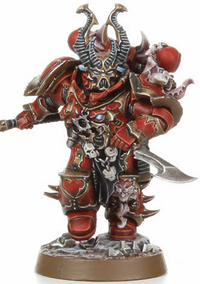
Warp-Forged Armour is a type of armour worn by the warriors of Chaos. It is, as its name implies, forged from the Hell Forges of the Forces of Chaos. As such, these armour are partially daemonic and, given the lack of supplies from the Traitor side, it sort of counts as a form of homegrown power armour. Warp-Forged Armour is often made by either the Dark Mechanicus or the Iron Warriors, as these chaps are the only ones with the know-how in how to create and maintain these things. These armour pieces are mutated and possessed by a Neverborn and often worked in-tandem with their wearer.
One major advantage of these armour pieces is the fact that being partially daemonic, Warp-Forged Armour could heal over time, which eases the maintenance cost by a whole lot, and given that CSMs are in constant need for a diaper change, this means A LOT.
This daemonic armour is laden with unholy runes, allowing Champions of Chaos or Daemons wearing it to be all but immune to the blows of enemy mortals. In part of its nature, Warp-Forged Armour can be considered as the Chaos equivalent of the Grey Knights Aegis Armour. Chaos Champions and Chaos Lords who adorn these armour pieces could gain the added benefit of their armour regenerating due to it being partially daemonic.
They offer the middle ground between normal Chaos Powered Armour and Fleshmetal Armour.
Also, it’s partially daemonic. In case no one told you.
-
Chaos Chosens in Warp-Forged Armour
Chaos Terminator Armour
Just like their loyalist counterparts, Chaos too has its own pattern of Terminator Armours. Most of which are of the older Cataphractii and Tartaros Patterns since Chaos aren't known for its high maintenance standards, so by the 41st Millennium, some factions have kitbashed entirely new patterns for their Terminators.
Chaos Terminators as such, come in a variety of colours and flavours just like their loyalist counterparts. This is seen in the following:
Chaos Cataphractii Pattern Terminator Armour

During the Horus Heresy the Traitor Legions fielded units clad in Cataphractii armour just like their loyal brothers. They offer the most protection and are thus the toughest of the Terminator suits and are able to take immense punishment before suffering mass systems failure. They were armed with Combi-Bolters, powerfists and Grenade Harnesses, but also had access to Chainfists, Lightning Claws, heavy flamers and power swords.
Like their Tartaros cousins, they aren't as twisted as the Indomitus due to their rarity and lack of exposure from the Warp. Whatever is left of these tainted Cataphractii are now irreplaceable relics since Chaos can't maintain for shit. So they are usually of much inferior quality as a whole. On the bright side, Chaos Space Marines could be blessed with the Four Chaos Gods for additional quirks.
Crunchwise, they behave similarly to their loyalist counterparts, with the addition of having Chaos-aligned special rules and CP. In a nutshell, they are tanky, tough and has access to the favours of the Chaos Gods which makes them more individualised than their loyalist counterparts.
-
Chaos Cataphractii Terminators.
Chaos Tartaros Pattern Terminator Armour
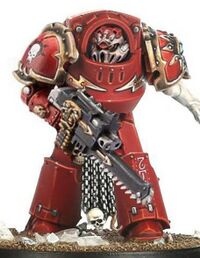
During the Horus Heresy the Traitor Legions fielded units clad in Tartaros pattern Terminator Armour, just like their loyal brothers. The most advanced and most mobile of Terminator suits, the Tartaros are surprisingly fast and can initiate a brief but surprising burst of speed to catch their enemies off guard. They are armed with Combi-Bolters and powerfists, but have also access to Lightning claws, Chainfists, Reaper Autocannons, Plasma Blasters, Heavy Flamers, Grenade Harnesses and Volkite Chargers.
Like their Cataphractii cousins, they aren't as twisted as the Indomitus due to their rarity and lack of exposure from the Warp. Whatever is left of these tainted Tartaros are now irreplaceable relics since Chaos can't maintain for shit. So they are usually of much inferior quality as a whole. On the bright side, Chaos Space Marines could be blessed with the Four Chaos Gods for additional quirks.
Crunchwise, they behave similarly to their loyalist counterparts, with the addition of having Chaos-aligned special rules and CP. In a nutshell, they are nimble, tough and has access to the favours of the Chaos Gods which makes them more individualised than their loyalist counterparts.
-
Chaos Tartaros Terminators.
Chaos Indomitus Pattern Terminator Armour

The most common and widespread Chaos Terminators and the most obvious. Similar to their loyalist counterparts, they are the most adaptable of the Terminators and are by far the most twisted looking due to the majority of Chaos Terminators wearing this particular piece of armor. Chaos Elephant Terminators are known for their notable tusks which has become an icon for Chaos Terminators. This is where the nicknames come from.
Now that the Horus Heresy fluff has been expanded, it is rather bizarre that these are the most common Chaos Terminators, as Indomitus Armor only became widespread after the Heresy, so most Chaos Legion Terminators should be wearing Cataphractii or Tartaros. Then again millennia of warfare and degradation has probably resulted in Cataphractii and Tartaros armour becoming quite rare due to the increasing difficulty in repairing it.
On the tabletop, these armour gives Chaos Terminators 2 wounds per model, making them as tanky as their loyalist counterparts with the addition on gaining access to the favours of the Chaos Gods which makes them more individualised.
-
Chaos Indomitus Terminators.
Scarab Occult Pattern Terminator Armour
See Main Page: Rubric Terminators

AKA Rubric Terminators or the Sekhmet. Scarab Occult Terminators were once the finest psykers in the Thousand Sons, bodyguards to Magnus the Red himself. Like their brothers, they were affected by the Rubric of Ahriman spell and turned into dust. Now they stride into battle at side of their sorcerous masters. Clad in ornate armor, they are armed with Khopesh blades and Inferno Combi-Bolters. The unit has also access to Heavy Warpflamers, Soulreaper Cannons and Hellfyre Missile Racks. The Sorcerer leading his unit also wields a Force staff.
Compared to most CSM Legions and Warbands, the Thousand Sons actually maintain their equipment quite well. While some may accuse them of excessive Nerdom, it may just be a manner of common sense which is a rare commodity in Chaos.
Strangely, the Sekhmet were the finest psykers of the Sons, so it is strange that they were rubric'd. However, the Sekhmet were rather emotionless and lacking in ambition, which doesn't fit well with Tzeentch's ideal sorcerers. Thus, rubric.
On the tabletop, due to being inanimate automatons, they get 2+/4++ saves as well as Fearless. What is surprising is that they lack the Slow and Purposeful rule, which actually makes them quite nimble for a bunch of walking trash bins. However, they still share in the Rubric Marines other traditional weaknesses. Such as general idiocy without a Sorceror and the lack of options to negate cover saves is a particular issue as the targets you'd want to use them against the most.
-
Scarab Occult Terminators. -
The Sekhmet Scarab Occult, pre-Rubric'ed.
Blightlord Pattern Terminator Armour
See Main Page: Blightlord Terminators

Blightlord Terminators serve as the disease-ridden elite of the Death Guard. They are bloated with disease and a myriad of parasitic organisms that spread a miasma of death and decay around them. They are so bloated with filth that their mobility has crawled to a snails pace; even regular Plague Marines can outwalk them. Despite this, they are orders of magnitude tougher then even regular Chaos Terminators and their status of being below a Deathshroud in rank is not to be underestimated.
Due to their level of mutation, they are forever fused with their mutated suits of Cataphractii Armour (A bit like Fleshmetal but more smelly), Blightlord Terminators combine diseased resilience with the protection and firepower of a standard Terminator. In battle, they serve as the elite shock troops of the Death Guard and are present in most warbands of the Legion and are essentially a neigh-unstoppable rape train.
Compared to the Thousand Sons' Scarab Occult Terminators, the Death Guard are the direct opposite when it comes to maintenance, for obvious reasons. Seriously, forget about even scavenging their equipment. Look at the damned thing.
Crunchwise, since they have Cataphractii armour, they are naturally a bit tougher than the standard Terminator. Since they are Nurgle's boys, they also get the standard +1 toughness and 5+ Disgustingly Resilient that regular Plague Marines get. All in all, a tough bastard to crack
-
Blightlord Terminators.
Fleshmetal Armour

Essentially the Chaos Marine's take on Artificer armor, given only to champions favored by the Chaos Gods, although it would be much more accurate to call it as a type of Terminator Armour.
A blast from the past editions, Fleshmetal Armour is how it sounds. After spending gods knows how long in the Warp and centuries of combat under chaos, it eventually caused a chaos marine's power armor to fuse with their own flesh, forming an incredibly hard, organic carapace, tempered by ceramite and reinforced with warpfuckery.
Once a marine receives this gift, they're now more literal weapons than ever, as the armor cannot be removed anymore (since its now their second skin), condemning them to an eternity of unending war. Of course, since Chaos Marines live for that kind of thing, its more of an encouragement than anything. The only exception to this are Helbrutes, who are driven mad by the process.
Like Warp-Forged Armour, Fleshmetal Armour could heal over time due to being partially daemonic. This eases up on maintenance as wearers of this piece of equipment aren't desperate to scavenge for bits and pieces if one of their servo-motors stopped functioning. The one major downside is...well...you can't take it off now can ya?
Just about any Chaos special unit or veteran has fleshmetal armour, like Obliterators and Chaos Chosen.
-
Obliterators in Fleshmetal -
Mutilators in Fleshmetal
Tau Battlesuits
Main Article: Battlesuit
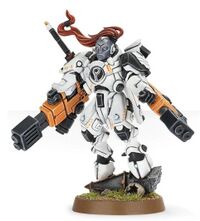
The Tau's take on "power armor" is a bit more diverse compared to the Imperium, that it encompasses both personal protection suits, like stealth suits, and giant weapons platforms, like Riptides. Essentially, the Tau put everything from a simple flight suit to Imperial Knight / Titan-Class mechs as "Battlesuits". In proportion to their size: Tau battlesuits generally have lower raw protective capabilities than their Imperial counterparts due to their emphasis on mobility, but makes up for it by having a slew of advanced tech to give them a leg-up on their foes.
The battlesuits that are more along with the other factions idea of personal "armour" instead of "combat walker"-type mechs or "a very fancy flight suit", are the: XV15 Stealthsuit, XV22 Command/StealthSuit, and XV25 Stealthsuit. The stealthsuits rely primarily on just not being seen (obviously), because you don't have to worry if your armour will stop a bolter round, if the enemy never knows you are there to be shot at.
-
XV15
-
XV22
-
XV25
Eldar Armour
Main Article: Mesh Armour, Aspect Armour, Exarch Armour, Phoenix Armour and Rune Armour

The Eldar use Mesh Armor technology to supplant their powered armor suits, said armor is made out of a combination of wraithbone and thermoplas, all woven together to make a futuristic mail armored suit. The suit is psychically attuned to the wearer's mind, so it is capable of tailoring its fit and use to the wearer's style.
While mesh armor doesn't seem or look all that tough, it's protective quality comes from it's ability to actively harden specific parts of the armor on neural impulse. Upon taking a hit, it will attempt to reduce damage by bulking up the affected part, then spreads the force of the hit's impact throughout the armor, which reduces the pain and injuries taken by the wearer since its not being concentrated to a single point of their body. We're not exactly sure how feasible this is, since the hardening only occurs upon getting hit (which means that the armor only has mere microseconds to do all this upon an object striking it), rather than in-anticipation like how reactive armor works IRL, but we're going to chalk it up to futuristic spehss elf magic.
There are currently a couple variants:
- Mesh Armor - Standard armor worn by guardian squads. Its also equipped with life-support functions and sensory equipment.
- Aspect Armor - Aspect armor are worn by Aspect Warriors. Each aspect shrine has their own take on Aspect Armor depending on their role, so Swooping Hawks and Howling Banshees have lighter armor, while Dark Reapers and Fire Dragons have heavier armor (although "heavy" is subjective as it still allows the wearer to be nimble like every other Eldar warrior). The main thing in common they have though, is that they're much more durable and flashier than standard mesh armor.
- Exarch Armor - Aspect armor worn by Exarchs. Because of the Exarch's seniority and experience; the armor is typically much more blinged out than the standard variant, offering the wearer more protection and other equipment options. Exarch armor is also adorned with the spirit stones of deceased Exarchs, bestowing the wearer with literally millennia of combat experience from past heroes.
- Phoenix Armor - The armor worn by the Phoenix Lords. Is so expertly made that it can withstand all but the most powerful and/or luckiest of hits, even after thousands of years. Phoenix Armor also stores the consciousness and memories of the original wearer, so in the event a Phoenix Lord falls in battle, he will be instantly revived when another living Eldar dons the armor again (although it has the questionable effect of completely overriding the future wearer's mind, with the Lord effectively making the unfortunate recipient a flesh puppet.).
- Rune Armor - Mesh armor worn by warlocks and farseers. Along with standard mesh armor tech, the suit is also inscribed with several runes that afford the wearer a greater deal of protection from damage, and also to better attune them to psychic energy. It also comes with an extra layer of wraithbone for more protection.
Dark Eldar Armour
Main Article: Kabalite Armour, Wychsuit , Incubus Warsuit and Ghostplate Armour
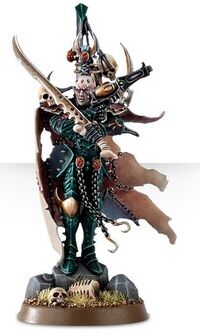
The Dark Eldar's armor is similar to their Craftworld cousins, although even lighter to accommodate the Dark Eldar's penchant for coke-fueled speed. Skimpier in the case of Wyches, who's career require them to show skin. They're also adorned with a plethora of spikes and blades, to the point that realistically: all those pointy sticks must affect unit cohesion and personal movement while in combat.
The few variants they have are:
- Kabalite Armour - The combat armor worn by just about every lowly kabalite that isn't going in naked. To further aid in movement: Kabalite armor is typically just a bodysuit, with armor plates attached where appropriate. They function similarly to mesh armor, in that the bodysuit hardens on neural impulse to deflect damage more effectively, and pressurized to allow the wearer to fight in hostile environments. Its also very, very spiky.
- Wychsuit - Not really "armor" per se, as a lack of one, but included for the sake of reference. Wych suits are flexible body gloves, cut away at certain places to show the Wych's good sides to the crowd while fighting in arenas or in the field. It offers very little protection due to the latter fact, as it's role is more for entertainment, than pure combat.
- Incubus Warsuit - The closest thing the Dark Eldar have to traditional power armor. It affords similar protection to that of Imperial power armor, whilst being so expertly manufactured that it doesn't inhibit the wearer's reflexes and agility in the slightest. The warsuit is completely exclusive to the Incubi, and not even Archons can pay/intimidate their way into getting a personal warsuit.
- Ghostplate Armour - Armor used by the poncier gits in Dark Eldar society, most notably Archons. The armor offers much better protection than bog-standard kabalite armor, whilst having a built-in forcefield generator. It also doesn't compromise on agility, as the resins used in it's construction are lighter and tougher.
Ork Armour
Main Article: Mega Armour
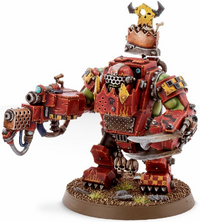
The only known variety of Ork power armour is Ork mega-armour, a direct Orkoid equivalent to Astartes Tactical Dreadnought armor. It basically looks like a chunk of metal or vehicle parts strapped together and called 'armour'. Or a miniature power lifter, whatever fits your definition.
Its weight (a ton or more) and complexity make it difficult to move and slow down its user, but it can withstand insane amounts of punishment, almost as much as Imperial Terminator Armour. Piston-enchased metal limbs of mega armour give the wearer phenomenal strength, and it incorporates fearsome weapons: a Power Klaw and Kombi-Weapon or twin-linked Shootaz. It often involves the use of built-in bionics and is very complex, which makes it very hard to manufacture, so it is a rare sight in Ork armies. Usually only Nobs (who like to call themselves "Meganobs" after acquiring Mega Armour) and Warbosses can afford such armour.
-
Big Mek
-
Ditto
-
Warboss
Fallout Power Armor
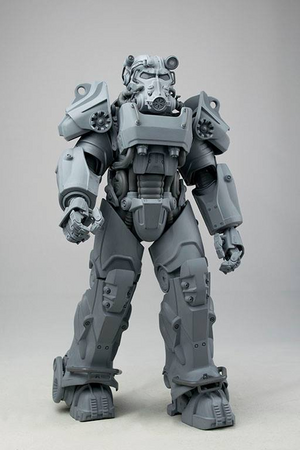
Unlike Warhammer 40,000, Fallout powered armor is Fluff-wise more "power" than "armor". It was originally made to allow troops to use heavy weapons on the move and with increased weight limit it was obvious to put some extra armor on the exo-suit. Even while it turns you into a nearly-indestructible walking tank, there is no shortage of stupidly powerful and/or armour-piercing weapons in Fallout, so sneaking and camouflage are always considered better protection than armor, so the main reason people use it is strength and radiation resistance bonuses. It is also possibly the most realistic armor here, strangely. Around Fallout 1 and 2, power armor was an almost cheat button up to the endgame, with an obscene bonus of +3 STR and near immunity to all small arms fire up to energy and heavy weapons(and Gauss in Fallout 2)
Afterwards came Fallout 3, where a leather jacketed character high on morphine could soak more damage than a sober power armored dude and mow him down with a cheap Chinese assault rifle. It had become a glorified metal full plate, met with RAGE until New Vegas came with some decent power armor, though it still got overshadowed by a badass riot armor that didn't need training(Lonesome Road DLC) or a clingy female AI driven stealth suit(Old World Blues DLC).
Power armor got a massive overhaul in Fallout 4, turning them into basically an infantry fighting vehicle rather than just better armor. The crafting system extends to upgrades and new systems for the armor, including neat stuff like a stealth field and a jet pack. On one hand Fallout 4 is one of the few games where power armour feels like actual power armour and not just the best armour you can get, but on the other, it was so strong they couldn't help but give it to you right at the start of the game (because working towards rewards requires an attention span they don't think we have, apparently) and had to change the fact power armour comes with an internal battery so you could only use it until you ran out of fusion cores. Which you never did as they were cheap to buy.
Power Armor Frame

Developed sometime after Alaska, the Army showed worry in maintaining the suits of armor they already had during a possible Chinese invasion. With multiple varieties currently in use, and more being developed, a version designed for ease of maintenance was going to be required. Instead, this was developed. Basically all the wires and joints of the armor without the actual armor, one can easily slap individual power armor sections onto the frame allowing for bits of damaged armor to be used to form up a singular complete suit. Think the Heresy armor from 40k above. With the internal workings bare it also made modifying and maintaining the armor a total breeze, though did come at a cost. All American armor post T-45 used a internal reactor allowing for centuries of use before requiring a recharge. Since every armor variety used a different level of power, putting in a reactor would have resulted in a situation of either too much or too little power being produced, resulting at best a sluggish barely working suit and at worst a nuclear explosion. Instead commonly used fusion core batteries were used as the power source. While these cores did hold much more power then the Microfusion packs of the T-45, they still didn't last long when used.
Fluffwise, a fusion core battery lasted around 10 hours on full charge, and that's just moving on a brisk pace, no sprinting or doing fast combat maneuvers, which would drain the battery even faster. While realistically this seems horrible to have to deal with during extended operations beyond friendly lines and a logistical and engineering nightmare to deal with in the middle of a conflict, there are ways to greatly extend the battery's lifespan (and/or optimize the armor's power consumption) through character skills and perks, so we'd assume that pre-armageddon, there were already ways to make the armor last much longer in the field, but these improvements weren't standardized for all suits yet by the time the bombs fell (since power armored troops stateside wouldn't have to worry about running out of fusion cores on their home turf, compared to the soldiers stationed overseas). That or Bethesda didn't think this concept all the way through and really shouldn't have overcomplicated the armor's power source in FO4, whichever makes more sense to you.
The frame was used extensively in the eastern region of America, but none were deployed to the West by the time the bombs dropped. For the record:
- T-45, T-49, T-51, X-01, X-02, X-03, and Horned Power Armor all have interal reactor versions (or Microfusion in the T-45 case).
- T-60, T-65 and EX-17 were built exclusively with the frame in mind.
- The original C-00 model no longer exists, so it's frame only for that guy.
T-45 Powered Armor

The first generation of power armor to go into the field, the T-45 series was rushed into service to hold back the invading Chinese from taking over Alaska. It worked and contained the invasion, but had a lot of problems. Later used on the homefront. The T-45d is most commonly seen in the Capital Wasteland.
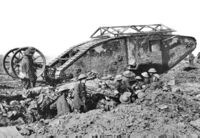
After Bethesda got the rights to make Fallout 3, they were like "Guys, guys, let's make a SHITTY POWER ARMOR!" and they went through with it. The result was far from shitty a mixed bag. Sure, it has -2 AGL, less radiation resistance, and makes you move around like the Comic Book Guy from The Simpsons, but it looks BAD-ASS!!! Noted for using Microfusion packs and batteries to power the suit like an RC car, which make recharging quick but run out of power often. As of Fallout 76, we have what could be considered a more canon representation than Fallout 4's. T-45 has the most common spawns of all the military armors and the lowest base spawn level. When compared to an at-level suit, it has worse protection than any military suit, but is lighter with a much cheaper price tag on builds and repairs.
NCR Salvaged Powered Armour

This is the 'zombie' version of the T-45d. After the Battle of HELIOS One, the NCR recovered many suits of T-45d from fallen Brotherhood Paladins. However, either because the NCR do not have the capability to manufacture spare parts, lack the actual knowledge to use and maintain power armor, or a bit of both, the "power" part of the armor was stripped, so its just...armor.
The servomotors that augments the wearers' strength have been removed along with a good chunk of the extra plating, and the back-mounted rad scrubbers were replaced with a cheap air conditioner so the wearer doesn't die from heat stroke while using it (and lords help you if you're patrolling in the middle of the desert with heavy metal plates all over your body). As its not "true" power armor, it does not require special training, nor is it vulnerable to electric-based attacks, so just about any mook with some measure of brawn can be fitted into it and send him off. The result is, for a lack of a better term, plate armor with an AC strapped to the back. It has less protective qualities than the armor it's based on, has no built-in rad protection, and has no mechanical assistance to carry all this weight since it was ripped out, so its cumbersome as all hell.
Its use is less for practicality and more as a moral and political tool, basically letting the NCR brag "See? We got power armored troops too!" without actually having the knowledge and technology to build and maintain said troops, which goes with the central theme of Fallout: people of the future attempting to recreate the past, without having a firm grip on what it actually is.
Crunch-wise....what you see is what you get. It has a -2 AGI penalty with no +2 STR bonus to offset the 40kg weight of the armor, or rad protection to help you wade through heavily irradiated areas, with some pretty alright DT if you have the full set. Due to the infinitely better late-game options for personal protection (either just as good with less penalties or full-on upgrades), the salvaged armor only becomes useful if:
A. You want to cosplay in power armor, without wanting to bother getting the perk to actually use it (as there are only two ways to get them, both of which are difficult and late in the game).
B. In need of scrap material to repair actual suits of power armor with.
C. You're really desperate for high-DT armor.
T-51 Powered Armor

The second generation of power armor, the T-51 series managed to get all the kinks ironed out. Used to kick the Chinese out of Alaska and invade China. The quintessential Fallout power armor suit. The T-51b variant is common among the West Coast Brotherhood of Steel. Two suits are known to be in the Capital Wasteland.
This armor only has +1 STR for some reason. What's even stranger is that the hunk of metal that you put on your head (AKA the helmet, but who calls it that?) gives you a +1 CHR bonus (probably because it's heavily featured in old world propaganda, but yet again, so was the T-45d variant). We really should be wearing around hunks of metal on our heads these days. After all, this armor be pullin' all dem bitches...
T-51b is the most advanced power armor that existed in the world before the Great War. Some confusion came with the introduction of the T-60 by Bethesda, who never bothered to tell anyone that this new armor was for the rank and file soldier while the T-51b was used by veteran squads. For the record, yes it is still the best and no the T-60 did not replace it.
Used as the standard armor for Paladins, the suit has become an icon (both in universe and real life) for the Brotherhood of Steel.
Due to a developer error that Bethesda never bothered patching, the Winterized variant that you receive as a reward for completing Fallout 3's Operation: Anchorage DLC is actually the version meant to be worn by NPCs in the Anchorage simulation, so it's functionally indestructible, with a whopping 999,100 HP (the version you were meant to get has only 100). However, the vanilla game's suit was involved in a rather difficult fetch quest (where you were hired to retrieve it for a ghoul called Crowley), and the NPC version of the winterized armour still has that version's quest script assigned to it, so taking it will prematurely mark that quest as completed by making the game think you stole the vanilla suit for yourself, locking you out forever. However, anyone in their right mind would have stolen the suit instead of giving it to Crowley anyway, it's not all bad.
X-01 Power Armor
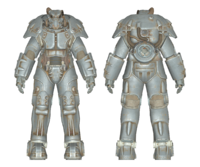
Developed as a prototype before the war, the X-01 was later improved drastically by the Enclave into the technologically sophisticated Advanced Power Armor. Crunch-wise, both versions are the same, though fluff-wise, the latter is MUCH better then the former, even if they both look identical. Standard issue for the Enclave (at the peak of their power) the Advanced variety of the X-01 to this day still outclasses all other power armor by a wide margin, utilizing secret underground engineering centres and factories to use the most advanced materials for construction. These things were BAD ASS, with the Enclave eventually losing the war thanks to
A: The player blowing up all that shit used to make them.
B: NCR using zerg tactics.
Sadly (for the Enclave), these aren't produced anymore thanks to losses in manpower and resources during the Enclave War, forcing the Enclave to develop and produce shittier armors instead. A neat little trick these armor had was an optional addition of tesla coils. In-game this is just better armor, in universe it uses small zaps of electrictiy to hit incoming projectiles melting bullets and detonating explosives before they can deliver their payload directly into the target.
Just remember the difference between the Prototype and Advanced versions. The former tends to have more balanced stats (4, 76) while the later tends to be OP (Fallout 2, New Vegas).
X-02 Power Armor

Developed by the Enclave Department of the Army after the Enclave's loss of the Oil Rig back in FO2. Produced in their base in Raven Rock, the X-02 was supposed to be a step-up from the previous X-01 series, utilizing lighter-weight ceramic plates that granted better mobility without compromising defense, a segmented armor pattern to better absorb damage, removal of the hump and replacing it with more traditional armored pauldrons, and a redesigned helmet that provides a more menacing but reduced head profile. They were apparently produced in enough numbers that the Enclave managed to phase out the older X-01 suits for these. Due to the black coloration and sinister helmet design, Brotherhood soldiers dubbed it the "Black Devil" power armor.
Crunchwise....well, it sucks. Atleast in FO3. It’s barely an upgrade over the T-45 armor (you know, the first armor the US ever fielded back in the Great War) and is completely inferior to the Brotherhood's T-51b armors, despite it being hundreds of years old.
It returns in FO4 as Creation Club content, where it now gets better representation as having the same stats as the X-01 suit (which is already a clear-cut upgrade over the more common T-51 and T-60 suits), but better energy weapon resistance.
X-03 Power Armor

Also known as Hellfire, the armor was produced near the end of the Enclave-Brotherhood war on the East coast. Basically an attempt to use more recent discoveries in robotics of all things, the armor is remarkably tough for something that costs only slightly more resources than the X-02, boasting a huge increase in heat resistance as befitting its name. Originally used by flame troopers, it has since become standard issue for the Enclave. As far as power armor goes it's above average. It's only issue is the heat resistance seems to mess around with the tesla coil systems no longer giving it the option without extensive modifications.
The armor becomes usable in FO4, and much like all Enclave-issue armors, is one of the best armors in the game in terms of pure protection stats.
T-60 Power Armor
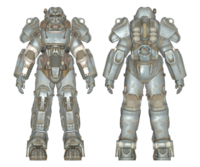
A new addition to the series in Fallout 4, introduced as the other “best” Power Armor. The T-60c was designed to supplement the T-51. With a more canonical stat base in Fallout 76, it has inferior protection levels to the T-51b. However, it is much cheaper to build and repair, making it better suited to mass production and deployment. This frees up the superior T-51 for deployment in elite units, which also explains the T-51's prominence among the Brotherhood of Steel until they set up for mass deployment in Fallout 4. It draws many of its design elements from the T-45, as that allows it to use many of the same internal components as the earlier models. The double pauldrons look is still silly.
T-65 Power Armor
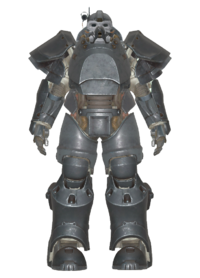
While this is yet another prototype armor, this variety wasn't even past the late concept phase, with only blueprints remaining. Developed by the Secret Service of all people, it was an attempt to fix one of the biggest weaknesses power armor had. Like old school armor, the powered variety had a number of weak points in joint and the neck areas allowing high powered snipers to disable the user (a common chinese tactic in Alaska was hit the knee with a Guass Rifle, then finish with a neck shot). The answer was segmented armor, allowing for substantially better coverage at the cost of increased cost. Like, HUGELY increased costs. This shit was made for exclusive use by the President's bodyguards for crying out loud. More solid gold Nintendo cartridges would have been built than this thing, and that’s BEFORE the war. Even the Enclave at the height of their power looked at this thing and said "Fuck that". Still, a couple were eventually constructed post war, but only in extremely small numbers and for an extremely short period of time.
EX-17 Excavator suit

Developed by Garrahan Mining Co., the basic idea was pretty obvious. If it gives the user strength and protection, why not use power armor for mining? Not many models were produced outside the company since by the time it was fully developed, manufactured and deployed, Robots had already taken over for the human workers. Woops.
C-00
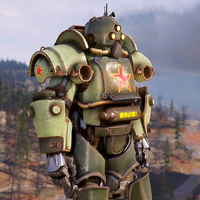
China had shown no interest in the concept of power armor originally, instead focusing heavily on the use of long term stealth fields (at the time stealth fields struggled to last more then a few minutes). While they succeeded with their stealth suits, the introduction of power armor by the Americans really showed the biggest flaw in the Chinese technological focus. Sure, being invisible helps in a straight up firefight, but when trying to hold a location against artillery, tanks and aircraft, more durability tends to have the advantage. Plus the fact the fields weren't perfect also didn't help. By the time China got around to doing their own research, they were years behind at LEAST. Plus, with the invasion of China, the product was rushed to the front. If you read the T-45 section above, you know where this is going.
It sucks. Badly. At this time, America had been using internal reactors in all their models for awhile, yet the Chinese version was still using the old microfusion cell method seen in the T-45 (read the frame section if this sounds confusing to a 4/76 fan) resulting in a very short combat period, especially bad considering they were first mass deployed in an AIRBORNE operation! Most of their veterans were also accustomed to using the stealth suit which could not be more different, resulting in China lacking any experienced users. Despite how bad it ultimately was, it should be noted that it didn't matter much as by the time it saw serious combat, the bombs had dropped. The only major thing of note was the idea alone of Chinese power armor made American Intelligence sit right the fuck up, resulting in the research and eventual production of a number of electromagnetic and pulse weapons which can be found in the wasteland to this day.
Voice lines are kinda cool though.
Horned Power Armor
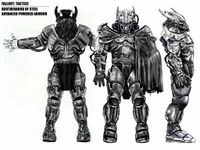
Used in the semi-canonical (due to Fallout 3, New Vegas, and Fallout 4) Fallout Tactics (Bethesda's offical stance is that the major events are canon, but many fans choose to believe the whole thing is canon) the Horned Power Armor is used by the Midwestern Brotherhood of Steel with it's defining feature being, you guessed it, horns. The Midwestern Brotherhood stands out as fully incorporating itself into wasteland life, offering protection to tribes and towns in return for resources, recruits, and information. This in turn is shown in the design of the armor, being the only suit designed from scratch by a Brotherhood faction since the war. Designed for mass production over protection (similar to the more recent Enclave designs), the armor still incorporates many mechanical elements from the T-51b such as an internal reactor. It's also slimmer and less bulky than other armor designs (though not on the same level of the newer Enclave designs).
Overall, the armor is a compromise between mass production and protection, with heavy modification possible due to the more scrappy way it is produced unlike the more industrial Enclave. While it is numerous enough to equip all of their Paladins (keeping in mind their numbers are MUCH larger then other chapters), it still leaves more of the lower ranking infantry to use more traditional protection.
The armour's horned helmet, greaves, and slimmer design are reminiscent of the Enclave's Mk. II advanced power armour (or X-02), which may imply that they're connected. One of the complaints about the original Tactics armour design was that it didn't look retro enough for Fallout, so it's possible that it's actually scavenged or stolen Enclave armour (which wouldn't be a stretch, since the Enclave are also known to have been active in Chicago), and the design was just "retrofied" for its reappearance in Fallout 3. Alternatively, it's possible that the X-02 was made by hybridising elements of this armour with the earlier Enclave X-01. Bethesda haven't said anything about the similarity though, possibly due to Tactics' weird place in Fallout canon.
Raider Power Armor

Raiders in the Commonwealth and beyond have managed to refurbish power armor frames, and by cobbling together scraps of T-45 and T-51 armored suits and scrap parts, this.....thing, was made. Raider power armor is the least versatile & weakest of all the armor types. It's complete shit against anything that has a caliber above .38 and laser pistols can kill the user within 4-5 shots. Turns out a bunch of drugged-out vindictive assholes who shun society are not the best engineers. Still looks metal as hell though, and it is still better than even the best non powered armor while being cheap as hell to repair.
Despite how it looks, however, it is functioning power armor. It’s not very good power armor, but it’s power armor. It’s fully sealed, so it has some measure of environmental protection, the servos work to an extent, and it meshes in standard power armor frames. Yes, this means that a couple of crack-addled junkies are capable of making and maintaining functioning suits of power armor, but a large nation state with an established technology base can't. This highlights Bethesda's "abilities" as storytellers, because Fallout 4 removed any requirement for special training in order to use power armor.
Vault Tec Power Armor

Power armor seen in the totally not canon and universally reviled Fallout: Brotherhood of Steel (not to be confused with Tactics which uses a similar name on the title). So why the fuck is this thing here? It's actually pretty well liked by the Fallout community. So much so it's popped up in all sorts of fan works and mods. The armor was developed by Vault Tec using the T-51b as a base (which was probably done behind West Tek’s back) for security stationed at Vault monitoring outposts and other installations with a actual purpose rather then to see what happens if you lock 30 people in a bunker with a panther. Similar to the original design, complete with internal reactor, a lot of the frame seems to use types of hardened plastic and silicone to cover more vunerable areas. This would have made the armor lighter and more flexible at the cost of below average protection.
Rifts Power Armor
The RPG Rifts has sooo much power armor, there's entire books devoted to listing different models of the things. Perhaps the most notable and iconic is the Glitterboy, named for it's shiny reflective armor, but most famous for the Boom Gun, a huge railgun so powerful it has to anchor itself to the ground with extendable pylons to keep from being knocked on it's ass every time it's fire, and which produces a sonic boom loud enough to deafen even superhuman foes wearing enclosed armor.
The main armor of the Coalition States is the flying SAMAS armor, which is cool and all and has mini plasma missiles but lacks a gigantic boom gun. Even though the CS views the design as their sole property, since it's based on a pre-cataclysm design a couple groups have their own.
Less common power armors include Centaur armor in case you want some extra horse legs, dinosaur power armor, the Angrar armor which is actually a pissed off demon who tries to corrupt you, and Chipwell armor, which cuts out all the super advanced alloys everything else uses and replaces them with something approximating tinfoil, for your bargain-basement power armor needs.
Battletech Battle Armor
Powered exoskeletons were a thing for civilian purposes in Battletech for centuries for civilian uses and some comparatively light power armor suits were used by the SLDF in the 28th century. However, it really came into it's own in 2842 when Clan Wolf took a Clan Goliath Scorpion diving suit design and militarized it. This development happened alongside Clan Hell's Horses coming up with a new beefed up strain of 2-2.5 meter tall Warriors, who they soon were plunking into these new suits. The result were known as Elementals, a nasty surprise for the Inner Sphere when they showed up in 3050. Post truce at Tuyyakid, and both Spheroid and Clanner factions began experimenting with a variety of designs ranging from light patterns capable of flight to quadrupedal one-man tanks able to take a BattleMech las-cannon blast to the face and still be able to fight.
Battletech Power Armor tends towards the bigger side of things. An Elemental Suit would weigh a Tonne, can tank some fire from BattleMech-scale guns, comes with a Power Claw equivalent to shred armor, a jump-pack to get away, and packs some serious firepower with an arm-mounted lascannon alongside shoulder-mounted missile pods.
StarCraft Power Armor

In StarCraft, the Confederate Marine Corps Power Armor, more simply called the CMC power armor, is the standard powered armor suit used by all military factions within the Koprulu sector. Despite the fact that each armored suit comprises a complex array of sensors and other advanced combat technologies, life-support systems, and its own independent power supply that appears to be a portable fusion reactor, it seems to be dirt-cheap as hell to manufacture, given that every armed force within the Koprulu sector can give one of these suits to every Terran marine worth a damn. Unfortunately, that technology doesn't seem to grant much actual protection; the marines are usually unceremoniously wiped out by the dozens hundreds during an engagement.
The main purpose of Armor for the Terran Confederacy and likely the Dominion is the armor protects the user from the vacuum of space first, seal the wearer inside it like a mobile prison and finally serve as combat armor. Umoja, on the other hand, values their all-volunteer forces but hasn't made many in-game appearances. The CMC armor is incapable of reliably protecting the wearer from projectiles, ruptures, or chemical attacks (apart from the passive hazards found in NBC environments), in both fluff and crunch, considering that it cannot hope hold out against: zergling claws, roach acid, the Marines' own gauss guns (hell, it can't even deflect the pistol rounds from their sidearms), fire and/or plasma, hydralisk spines, Mutalisk wurms, Psi attacks, Protoss photon guns, and really just about anything. Then again even tanks, huge giant robots and battlecruisers could not hold against said attacks en masse - this might say more about how nasty are weapons in StarCraft universe rather than how shitty is armor there, or more likely it's how real-world armor works. In fact, some of the fluff describes it as existing more to protect the wearer from the recoil of the Gauss than anything else. In addition, Starcraft armor is primarily ablative - no armor in the game renders anything in the game immune to damage. However, it should be noted: Fluff stated at certain points people got blunt force trauma'ed to death by the gauss fire, even inside the suits. Besides that, acid, if applied to joins in the suit, burns through those and not the armor. Since mind attacks are, well, mind-based, armor ain't gonna do shit. It's really just Spess Suit first, prison second, and body armor third.
Other variants exist, based on specialized functions. Medics wear a light armor that isn't designed for combat, but which carries advanced field surgical equipment and even some minor cybernetic construction equipment, allowing them to patch up wounded troopers and fix their busted armor. More visually distinctive is a model of power armor worn by Firebats. The armor is much bulkier than the standard armor, which, keep in mind, was already similar in size to terminator armor, especially in Starcraft II, where the thing's arms and pauldrons are bigger than its legs. Since the armor's bulk makes it thicker, it can take far more abuse than the regular armor. As the name of the unit might indicate, the armor uses a pair of built-in flamethrowers. The armor worn by Marauders in Starcraft II looks almost identical apart from a change in color, and has the same durability, but in place of flamethrowers uses grenade launchers that are best used against armor. The visual similarity between the two is neatly explained by the fact Marauder armor is rebuilt and re-purposed Firebat armor. Despite the armors' size (and concomitantly longer legs), the guys using them are just as slow as regular marines (oh come off it, the legs aren't much longer. they're lucky to not be slower). A third type of armor is made for Reapers, which looks similar to Assault Marines except their jetpacks are bigger.
Less well known, but still present, is the armor worn by the Protoss. This advanced alien armor, although considerably more "ceremonial-looking" than Terran armors, is actually significantly more durable. Not only is it comprised of more resilient materials, but it contains built-in devices that convert the bearer's psionic energy into a forcefield; though this is depleted by absorbing damage, it will eventually regenerate, if the user survives. Presumably, it also provides environmental protection, though that may have something to do with the fact that the Protoss' alien biology makes them hardier than humans, even without armor they can take more abuse than any Terran CMC armor variant. The common "Zealot" armor also has wrist-mounted devices that can focus psionic energy into energy-blades, which they use to rip 'n' tear shit. Dark Templars use similar devices to create "void blades", whose alien energies are one of the few things that can permanently kill "ruler" type Zerg such as Cerebrates.
Starcraft armor is often mocked for looking fat and bulbous, something which grew more pronounced in Starcraft 2. This is also worsened by Starcraft suffering from "elephant seal-itis" much like Warcraft, where the men tend to be so big in comparison to female models that you wonder how anyone has heterosexual sex without breaking female half of the equation. The pre-rendered CGI models aren't too bad about this although they certainly are on the fat side of armor design when the general trend in sci-fi aesthetics has been to make things sleeker and slimmer, but the in-game models are pretty awful about this. The Starcraft 2 Firebat and Marauder look tubbier than the god damn Centurion. The very fact that Starcraft's power armor manages to make Space Marine armor look slim and sexy is the source of a tremendous deal of derision from Warhammer fans.
Metroid Power Armor
AKA the "Power Suit" or "Chozo Power Suit", and one of the most powerful armors on this list. Like Starcraft, pretty much every scrub gets a power suit in Metroid (especially if you're with the Galactic Federation), but the main character's suit is the one you probably want to know about. Samus Aran's armor is like a wearable, form fitting Titan, designed by magic bird people who took Samus in after her parents were killed. It completely kicks the shit out of basically all other technology in the Metroid universe; while a Federation plasma cannon is as powerful as a charged shot of Samus's Plasma Beam (which slices through aliens like a knife through warm butter), it's also nearly as big as a person, takes several minutes to charge, and requires a heavy power pack, while the proper Plasma Beam is integrated with all of Samus's other weaponry into her forearm-sized cannon, takes seconds to charge, absorbs ambient atmospheric energy to function, and is so energy-efficient it doesn't dip into her suit's resources whatsoever.
But that's not all, it's ridiculously modular and can accept pretty much any piece of technology ever and turn it into an upgrade, even if the Chozo had never once encountered the technology in question! Samus doesn't have any idea of how this works either but more or less all she knows about the suit and its functions is that it works.
When fully upgraded to end-game status, the Chozo suit is an unstoppable engine of destruction that's not only ludicrously durable but also incredibly fast and amazingly well armed. The only real flaw in its design is that it is stupid easy to knock all of its power ups and reset to default -- Samus never manages to hold onto her upgrades between games, though it could be because as we know that power ups can be destroyed (from metroid prime), she decides to just store them somewhere safe when she doesn't need them since most of her power ups are relics made by a species no one has seen a living example of in years. Like all Power Armours worth their name it also has pauldrons; the default pauldrons are actually pretty small, but add a Varia upgrade (where some materials have listed the pauldrons as a cooling system associated with the upgrade) and she can shame even the most ridiculous Space Marine. However as Metroid has grown older, Samus' suit has become sleeker and more form fitting. In the transition from Prime 1 to Prime 2, her varia suit became considerably sleeker, with the most notable changes being that her visor went from a T to a Y and that her pauldrons went from going to a bit above her brows to being low enough to offer her full peripheral vision. This suit design was kept as the official one (super smash brothers brawl's preference of the 2-D style "straight visor" suit notwithstanding) until Other M.
Until other M, the sleekest and slimmest power suit was the light suit, where the pauldrons were downright tiny and looked like something that would allow a full range of motion, meant to emphasize just how advanced and glorious the fusion of chozo and luminoth technology was. Then Other M came and essentially made the Light Suit's proportions the standard, with the pauldrons now being at most going up to her chin if not shorter. Whereas her older suits were bulky and androgynous, right now her default armor is pretty obviously worn by a woman even if it lacks anything egregious like boobplate or high heeled boots thanks to its pronounced hour glass figure. While not subject to as much criticism as the Zero Suit this redesign certainly has a lot of people who aren't really much of a fan of it. Whether it's out of simply disliking the aesthetics or that Nintendo's preference for it seems to be them showing favoritism for the extremely contentious Other M game over the almost universally beloved Prime trilogy is dependent on who you ask. To be fair, there's as much criticism of the Zero suit for looking like impractical fetish gear as there is criticism for it overshadowing what should be Samus' default appearance in marketing in an attempt to appeal to waifu seeking weebs.
In Metroid, Power Armor seems to be a ubiquitous and easy to manufacture technology. Basically the entirety of the Federation military, both Marines and Army are equipped with it. All of the hunters in prime hunters could outfit themselves with shields comparable to Samus' own suit, and one of the hunters; Sylux (Metroid's resident ensemble dark horse and probable pretty boy given Nintendo's recent male character design) has a suit of power armor that's basically equally matched to Samus' when both have a similar level of upgrades in every way. Notably Sylux's armor is said to most likely be a stolen federation prototype from a black ops research base that was destroyed some time ago, as is his ship. So clearly the Federation was aware of the massive gap in capability between their troops and Samus Aran and was trying to rectify it until whomever Sylux is stole it and totaled all of their research on the project. However by Metroid Fusion it seems the Federation at least has the ability to replicate the software portions of Samus' technology, which has some disturbing implications given that Fusion exposed the rot at the Federation's core.
As for how Federation grunt power armor performs. Federation Marines seem to be generally evenly matched with Space Pirates who seem to be greatly physically superior to the average human based on the athletics they constantly do. Whether or not it's shielded is unknown, but twenty or so marines made a pretty decent last stand against a hugely numerically superior force of Ing possessed Splinters (dog sized predators who seem to be aether's equivalent of wolves and who become much more durable when possessed by the Ing) before being inevitably overwhelmed by their enemy's sheer numbers. The Demolition troopers whom you have to escort in the last leg of the pirate homeworld's arc of Metroid Prime 3 to destroy a gate blocking the way to the phazon leviathan can also more than pull their own weight against the unending hordes of Space Pirates the Pirates will throw at you the moment they realize that you're on your way to destroy their leviathan. And their armor is actually noted as somewhat weaker than is standard for Federation marine armor (which...doesn't make a terrible deal of sense for soldiers whose job it is to handle explosives in the face of heavy enemy fire, that's a kind of job where you would want as much armor as you can get away with having) which makes it even more impressive.
There's also Federation Force's clunky Golem project Mini-Mecha but the less we speak of Federation Farce the better.
Halo Power Armor

Most people think of the Spartan power armor when they are asked about Halo. These suits cost as much as a UNSC ship and have the decency to protect the wearer from multiple Fuel Rod shots, despite being penetrated by a single pistol shot...inconsistency aside the Spartan power armor is in between the strengths of Astartes power armor and the Terran power armor. Unlike most other armors, the enhanced speed and strength given by these things is too much for an ordinary human; anybody other than the Spartans, who underwent genetic enhancements, and had a large wire stuck into their brain, ends up getting mutilated in the armor just by trying to move in it. Other power armor in Halo includes both the Brute and Elite combat harness which boosts their already insane strength (twice that of a human of the same mass for elites, about two or so tons for a Brute) and reaction time (although Brutes tend to be a bit more sluggish than humans).
The energy shields in the power armor are probably the suit's most vital asset, as without them no human, genetically modified or not, could possibly survive eating at least 10,000 rounds in a single battle. Besides this, later games add a number of armor upgrades that radically augment the suit's features, such as a jetpack, bubble shield, EMP blast, etc. Sprint used to be an add-on, for... some reason, but fortunately became a standard feature.
More noteworthy perhaps for the fact it does not cost as much as a spacecraft, does not have pauldrons the size of the user's head and is implied to be halfway to efficient or practical (but if you took away its active ingredient, the shield generator it becomes as useful as wet tissue paper) and is used by the SAS in SPEHSS is the ODST armor, which has both better data analyst equipment than the MJOLNIR and suspiciously similar play style to the piece of junk used in halo 1.
Of course there are the Forerunner Combat-Skins, which the books hype but the games tend to show much less impressive technology that makes the books make very little sense trying to reconcile the two. Whether it is used to dumb down the difficulty to make the game playable or pull out some ill-contrived bullshit excuse to explain why the Forerunner tech can be taken down by the magic of 7.62 NATO rounds is often a point of contention. For example, the books describe mini-mecha suits that can command a million drones or level city blocks but how you can reconcile this with the British B1 battle droids as designed by Apple that make up the bulk of the Prometheans in Halo 5 is anyone's guess. Whilst 343i tried to explain that the Prometheans were the byproduct of a madmen not giving a damn about quality control, it immediately contradicts itself when we see those same Prometheans suddenly blowing up Forerunner starships with the same weapons that many of us considered as 'meh' in the game itself. One also has to remember that Sentinels and Prometheans still have to be close enough to the suits in power to be relevant on the same battlefield before you run into the question that plagues many a superhero team, the age old "how is Hawkeye relevant on a team with Thor and the Silver Surfer?" It certainly doesn't make much sense when the Boredom Eternal/He of the endless recycled boss fights can take on a ludicrous amount of direct tank shots but can be taken apart with a combat knife and is supposed to be some badass guard figure. Then again, Halo isn't really known for its plot consistency and rivals WH40K on how unreliable the sources are.
It is also worth noting that Forerunner armor comes in mini-mecha and form-fitting varieties. Most of the above is for the mini-mecha, while form-fitting armor seems to be substantially less impressive. This is probably reconcilable by the people working on the Games having a completely different vision of the Halo universe than Greg Bear who likely recycled some concepts he had from unfinished books for the Forerunner trilogy. In the mean time, 343 took whatever it saw as having interest for its game ideas (namely the Ur-Didact and Librarian characters) and largely ignored the rest. And of course, Halo 5 had a completely different writer than Halo 4 and Halo 5 is so far regarded as having by far the worst writing in the entire series out of any of the games. Where everyone is out of character, the people who aren't out of character are so boring you won't remember a thing about them after finishing, several plot holes that was pulled out of everyone's asses and absolutely everyone is an idiot and all eight of the main characters are so superfluous to the plot that you could remove them all and not a single thing would change.
While Halo Spartans used to be pretty top of the line impressive for visual scifi; as the Genre has matured the genre has also become full of far, far more over the top settings as it becomes more and more possible to display over the top stunts. Much like how Superman's initial power level quickly ended up being eclipsed by various golden age competitors, a lot of what MJOLNIR armor can do has become so bog standard in science fiction (especially because a lot of its touted in game features are now standard for every FPS protagonist; apparently the first world war was fought by a bunch of wolverine clones, who knew?) that it's lost a great deal of its luster. To its credit Halo has avoided the route Superman underwent back in the Golden Age where he just kept on getting more powerful to one up his competition like Captain Marvel in the comic book superpower arms race; but if you're used to playing Warframe or something like that you can come into Halo wondering why Master Chief is supposed to be special. In which case congratulations for missing the entire point of the Spartans and the Master Chief. They are special because despite the power of their enemies they still manage to win through a combination of dumb luck and mind-boggling courage and tenacity that is intended (and succeeds in) engendering respect and admiration in the audience/player.
Marathon Power Armor
Halo's grand-daddy has one or two examples:
One (maybe) is a human standard issue Battle Armor designed to allow the wearer to fight in hard vacuum (and underwater). While designed as a space suit with several minutes of pressurized oxygen first and as armor second, it also has an energy shield that consumes suit power when protecting against combat and extreme environments, wholly dependent on external power supply to be recharged. It also has a suite of sensors and helmet HUD readouts including Halo/Aliens-style motion sensor, automapping with IFF transponder tracking, cameras with transmitter and optional "hypervision", and voice comms. Although the only guy seen wearing one is the protagonist, whose… inherent capabilities make it difficult to judge whether the Battle Armor offers any additional benefits to strength and speed.
The other is the Pfhor "Hunter" armor worn by the local Elite-equivalents, who serve as Heavy Infantry and dedicated slave hunters. Aside from vacuum capability, it has an integral shoulder-mounted plasma cannon in keeping with its blatant Predator/Yautja trappings, and also comes in a 1.5x bigger mini-mecha version.
Metal Gear Exoskeletons
Exosuits have featured throughout the Metal Gear series. While not very /tg/-ish, they do deserve a spot on this list for being either balls-out wacky or complete awesome.
Solidus's Powered armor
The powered armor suit worn by Solidus Snake during his rebellion. It uses artificial muscles that grant him vastly increased strength and reflexes (to the point he could parry concentrated machine gun fire with just his swords) and an accelerator that acted like a booster to allow him to travel great distances in the blink of an eye. The suit could "Hulk up", the artificial musculature bulking out for even greater strength enhancement. It was also equipped with an extra pair of limbs called "Snake Arms", very strong robotic tentacles mounted on the shoulders that could also shoot "plasma" missiles. However that works. They probably meant to say Plasma Bolts.
The Octosuit
Solid Snake's signature suit in MGS4, it was made of artificial muscles like Solidus' suit. Because he'd turn into an old fart at this point, the octosuit was less of a performance-enhancing set of power armor as it was a full-body prosthetic. Still, it allowed him to fight as well as his younger self, with the added bonus of the Octosuit passively copying his surroundings to allow him to blend in better. With the added facemask, he could even fully disguise himself to remain totally inconspicuous in public - doesn't work on murderous robots at abandoned military facilities, however it does give him enough strength to knock them over. Of course, the player should have Snake shooting those damn things instead. As rolling into Gekko successfully is basically up to the RNGs.
Cyborg Exosuits
After the fall of the Patriots, cyborg technology was released into the world. With CNT muscle fiber being as cheap to produce as plastic, just about every mercenary insane enough opted to be augmented and encased in one of these things. This armor enhances the wearer's strength, agility, and durability to absurd levels, basically turning them into unstoppable murder machines that will completely wreck the shit out of anything they face.
The caveat to this is that majority of cyborgs are not mentally sound for a variety of reasons. While some accepted augmentation willingly to enhance their abilities or restore lost functionality (and are thus able to come to terms with their new life), there are many who were forced to undergo cyborg transformation, either through force or grave necessity (a lot of cases were that they were former soldiers couldn't find jobs, either because their home country was in civil war, their country's economy was floored by the post-SOP recession, or they're disabled. So it was either sign up with a PMC to armor up or you and your family starves to death). Those recipients can be injected with fear-inhibiting nanomachines that will force them to fight, regardless of the circumstances, all while their inner self is trapped, screaming, in their mind and is unable to stop themselves.
Some of the more notable examples include Gray Fox, the Patriots' first Cyborg Ninja, who was resurrected and became a guinea pig for further genetic experimentation. His exoskeleton was grafted to his own skeleton to allow him to safely utilize its strength-enhancing features, such as incredible strength and reflexes. However, he wasn't alright in the head. Fox was forcibly brought back from the dead and put into the project against his will, due to this his only ambition in his life is to have one final duel with Solid Snake before finally being given eternal rest.
Raiden was captured by the Patriots and turned into a cyborg in Area 51. Everything from the jaw down was removed and his mandible-less skull and dangling spinal cord were attached to a cyborg body. The increased strength allowed him to break dance with 10-foot walkers attached to his legs and have a stabbing match with a bisexual flamenco-dancing vampire and duel and throw a Metal Gear RAY into the air. A later body, built exclusively for combat, gave him the facilities to fight and suplex a Metal Gear the size of a Warhound Titan, then tear off one of its arms to engage it in a duel and destroy it. The hyper-specialization for combat meant that this body couldn't have a self-repair unit; instead, Raiden had to take fuel cells from other military-grade cyborgs to repair any damage he might sustain and replenish his fuel, by forcefully yanking it out from them and consuming it on the spot.
Sam's Powered Armor
Defying all semblances of coherency; Jetstream Sam, a Brazilian samurai and Raiden's eventual rival, used nothing more than an exoskeleton to give him abilities that not only completely outclassed Raiden's original cyborg body (who, mind you, is able to lift a 30-foot mech and throw it into the air), but be able to go toe-to-toe with Raiden's later custom built body (who is able to bodyslam a Metal Gear the size of a Warhound Titan). By nothing more, we mean he had little-to-no cybernetic enhancements (his only real one is a cyborg arm after losing his sword arm, and even then he was capable of dueling a Metal Gear RAY UG all on his own before getting it).
It did just about everything Raiden's body could do, from repairing itself by ripping out people's spines, grant him unreasonably high strength, and give him fast-enough reflexes to slow down time, deflect bullets using nothing more than a sword. and reliably catch his sword after launching it out of his scabbard at high speed using an explosive quick-draw system. One wonders if cyborg tech is even necessary at this point considering Sam can do all this bullshit without getting his arms and legs amputated. Just like Armstrong he was quite loaded. So he most likely wasted his family fortune on upgrading his weapon and power armor.
SLA Industries
Power armor in SLA Industries is what Imperial power armor would look like if the Imperium were a secular plutocracy devoid of medieval flourishes. Almost all are based on some kind of fancy ceramic plating, are fully sealed, anti-dazzled and posses absolutely god-tier battery life. The lower end suits merely disperse their own weight while the higher tier's are effectively mini mecha designed to shrug off anti-vehicle rounds (unless their specialty high-explosive rounds, and those are almost extinct in 2nd edition) and mulch things in melee.
There are also rival company power suits, most notable and iconic being that of Thresher, who on top of being super durable have an onboard HUD that constantly calculates the most optimal approach for it's user, whether it's for movement or combat. There is also Thresher's "Sarge" suit, a Baneblade on legs for when the GM has absolutely had enough of the player's shit.
Marvel
Marvel comics has the most famous examples of Powered Armor. From the minds of Stan Lee, Jack Kirby, Larry Lieber and Don Heck to the printing press from movies to video games.
Iron Man suits

Probably the most well known Power Armor suit in fiction, popularized by the Superhero whose power is that he has power armor. Tony has built a lot of suits, some meant for a specific purpose, some just a stronger version of older iterations. At the high end, Iron man's suit is flat out superior to anything in nonserialized science fiction short of a few cheese builds from role playing games (but hey, comic books), even allowing him to fight Odinforce Thor, who mind you, has the power of a being who can destroy galaxies as the side effect of his fights. Sure his standard suits may be beaten by weaker stuff, but if he really sets his mind to it, the things Tony can build are essentially magic contained in metal and get shit done! He even built one for his amazing friend Spider-Man.
His armor has been constantly getting exponentially better in recent years. First was the Extremis armor that let him use technopathy in tandem with a super soldier enhancement. Then was the bleeding edge armor which could basically form weapons as Tony needed them from nowhere from living metal. Then was the Endo-sym armor which was not only able to do that but drain energy from anything and output so much energy that it can hurt even energy absorbers. And now he has the Model-Prime armor which can not only do all that but also automatically transform into any other kind of armor he needs whether it's a bulky Hulkbuster suit for raw strength or Samurai esque armor when Tony feels the need to express his inner weeaboo. Since the older Bleeding Edge armor is low Herald level (as in Herald of Galactus) he should be able to fight the gods of monotheistic settings and win against most of them!
It should also be possible for Mark 50 Tony in the MCU to defeat most deities too. As anyone who lasted more than three minutes in a fight with against Thanos when he has at least four Infinity Stone or more for longer than three minutes has at least Solar System level damage output and durability. The MK85 nanotech armour also allows him to wield all six infinity stones for a short while at the end of Endgame's big CGI punch-up after he steals the stones out of the nano-gauntlet, and also allows him to channel their power to dust-ify big boi grape and his army. Although it can't prevent the gamma radiation created by the stones from killing Tony in the process. The only reason Thanos or Professor Hulk survived using them is because they were using one of the gauntlets, big grape was turned into a cripple while Bruce came out with an injured an arm.
The depiction of the Mark 1 suit in the first Iron Man film is perhaps one of the best depictions of a power armor in film. Totally resistant to small arms fire (despite the large holes for his eyes, and his relatively unarmored gloves) carrying a entire squads worth of weapons on one unit: Two flame throwers, and a rocket launcher. It was even equipped with rocket thrusters for launching him out of the valley he was imprisoned at. However it was highly damaged by a HMG, which is totally realistic for how makeshift it was, and it fell apart completely after landing in a sand dune.
Destroyer Armor
Perhaps the snazziest and most powerful armor in fiction. This creation of Odin (Marvel Universe version) cannot be damaged by anything less powerful than Odin himself (characters who can smash planets to pieces have tried and failed) and can destroy just about anything weaker than Odin in a single hit. Forerunner suit, Starktech? HAH. This is made by gods who actually feel godlike. Crafted by someone who could eradicate entire galaxies as a side effect of his fights to battle even more powerful beings. Accept no substitutes, this is the finest power armor you'll ever find that does not ascend you to Celestial wonkyness. Even if it does run on magic.
Humorously, this armor was designed to fight the Celestials that shows up in the story and immediately one-shot it. In a bizarre turn of events the armor has become intelligent and now serves Galactus as a herald.
Comic books are weird.
Strike Legion
Strike Legion has teraton pistols, Uzis that can outgun all of WH40K and planet busting grenades. You can survive those in one of these babies. Even the weakest ones have built in shield generators and flight capabilities. That is really all that needs to be said. They are also mass produced. Like, standard issue level mass produced.
X-COM


X-COM always had high-tech armor, including actual power armored suits in the first game. The first one is the "Titan" armored suit, a heavy personal powered armor suit composed of alien alloys. These could drastically reduce damage, give the wearer increased strength and stamina. The other is the "Archangel" armor, while less durable, it instead sported a personal jetpack that allowed the user to hover and fly for limited amounts of time until they ran out of fuel. Finally, there is "Ghost" suit, which get more emphasis on power part of power armor, granting increased mobility and maneuverability, while only being slightly more durable than carapace armor, and as the name suggests, it spotted both passive camouflage systems and active cloaking. They're all fully sealed from the outside-environment and had an array life-support systems, so the wearer was immune to poison, fire, and getting choked to death.
However, in the Enemy Within expansion to the 2012 remake. This came in the form Mechanized Exoskeletal Cybersuit troopers, or "MECs" for short. Departing from the usual type of armor, these require a considerable amount of cybernetic enhancements through the use of the game's Meld resource to use. The pay-off for that is enormous, however. Unlike other low ranking soldiers in X-COM, the MEC troopers are extremely durable (to compensate for their size meaning they can't use cover.), and can use the most powerful guns in the game, that only the MEC's strength and durability allows them to use. Additionally, subsequent rank-up abilities and suit upgrades will further make MECs much more killy, and can improve the small ammo clip of the main gun.
However, while MECs are incredibly powerful, they are not invincible. They are like XCOM's equivalent of tanks, and much like tanks, they tend to draw the biggest amount of enemy fire in the map (This is made more problematic by the fact that even the aliens' basic plasma pistol can be a threat to MECs and the enemy AI will usually prioritize anyone not in cover), very limited ammunition stores which force frequent reloads, and just generally tend to lose against numbers where they're simply drowned by the sheer amount of attacks that come their way. Thus, relying completely on MECs isn't the best strategy, and it is always best to supplement MECs with some infantry for support. Another in-universe drawback to turning your soldiers into MEC troopers is that they have to have all of their limbs amputated to interface with the suit, though a number of Gene Mod upgrades available in Enemy Within would logically simplify the process of storing and reattaching their limbs at a later date.
Since the technology for the MEC troopers is taken from the alien invaders, they unsurprisingly have their own version called the Mectoid. The Mectoid is one of their basic troopers, the Sectoid, in their own MEC suit. By the sequel they have phased these out and instead have Advent MECs, which, like the sectopod, are fully autonomous and have no living pilot. The Advent MECs are equipped with giant mag cannons and triple shot grenade launchers. And can jump 30+ feet. Failure to incapacitate (or hack) one as soon as it's encountered will end in much rage. unless you have end game weapons
In XCOM 2 power amour takes 3 forms:
- The Wraith suit, which is similar to ghost armor in that it trades some protecting power for increased maneuverability and dodging ability. Trades ghost mode for wraith mode, which lets you walk through all obstacles for two turns. Also comes with a grappling hook.
- Basic power armour called the warden suit.
- And the "Hey guys let's strap a even more powerful Exosuit power thing on to power armor and slap a thermonuclear weapon onto the wrist and see what happens" WAR suit.
It also can have WH40k armor and weapons. As there are now several 40k mods on the Steam Workshop. Mods for the old EU/EW Mecs and Power armor also exist. Though you need the corresponding DLCs to use them.
Warmachine

Warmachine has had a number of different armors that technically qualify as power armor (almost all warcaster armor, for instance, includes enhancements to the wearer's strength and speed fueled by their magic), but probably the closest (and likely most famous) thing it has to traditional power armor is Khador's Man-O-War armor. Designed because Khador found it the lack of materials to make cortexes for its Warjacks meant even with the effort it put into building its jacks to last, it had a problem with still having a lot of resources it wasn't using and its lack of any cheaper jacks meant the jacks it had tended to be too badly outnumbered. To compensate for these problems, they designed huge suits of armor that would allow the wearers to function almost like pseudo-Warjacks. The Man-O-War functions the same way Khador's jacks do: it's slow, heavily armored, and hits really hard when it gets in close. Fluff wise there's a problem with the built in boilers releasing steam where it shouldn't go and killing the wearer, but this doesn't show up in gameplay since it would make them too unreliable (plus it only happens when they're damaged enough, depending on the addition to the game). Not that they care as they gladly DIE IN STEAM!! Since the armor is still expensive to manufacture, Khador only allows its veteran troops to wear it, meaning they possess high skill with melee weapons.
While the Man-O-War is an industrialized solution to lacking mechanical brains for light warjack-production, they are not the only power armors in the Iron Kingdoms: Some very eccentric mechaniks actually build their own armor called "Ironhead armour". Though the Man-O-War-armour is big and scary, these tend to be even larger and impractical, and are usually built so only the bearer can use it properly. The use for these is everything from mechaniks-work to warfare, as proved by Captain Dominic Darius of Cygnar, who actually build himself a small, wearable light 'jack which in turn creates new miniature 'jacks called Halfjacks as long as he activates the thing. The thing is a four-ton heavy machine, that births smaller machines at all times. I couldn't make this shit up.
Also, the Iron Kingdoms RPG allows players to own these armors - The Gods, Nations and Kings expansion allows for the use of Man-O-War armour and career, and the 52# issue of No Quarter has rules for your own custom-build murdermachine of steel and awesome.
Star Wars
The Star Wars Expanded Universe has had some minor power armor use. The iconic Stormtrooper armor is unpowered, but certain specialized variants like the Hazard Trooper and the zero-G assault Stormtrooper ("Spacetrooper") do use power armor. Dark Trooper armor itself was bigger and had strength enhancing and protective systems, but the mobile factory ship the project was based on was destroyed by Rebel agent Kyle Katarn. It incorporates a set of thrusters and other integrated weapons. Visually, it looks a bit like a cross of Terminator armor and NASA's Manned Maneuvering Unit, with a goofy, oversized Stormtrooper helmet. The less common Phase III Dark Troopers, which functioned as both automated robot infantry or could be worn as Power Armor, and were pretty much 40K Terminator Armor that wasn't hunched over(Soloing tank columns,anyone?), and had a built-in jetpack along with fun stuff like micromissiles. Sadly, like all cool things in the Star Wars universe, it shows up for just a couple games and books, then gets immediately destroyed and you never use it.
Ultimately, power armor isn't used as much, since some sources indicate that the materials used in regular armor can hardly stand up to small arms like the ubiquitous blaster, nor the much rarer but much more asskicking lightsaber. This is maintained in RPGs and video games where power armor is merely more effective footsoldier armor with some enhanced muscles, rather than immunity to small arms a proper armored vehicle has. Ultimately, power armor is practically useless in the universe when compared to Plot armor.
S.T.A.L.K.E.R.
The S.T.A.L.K.E.R. series features powered exoskeletons. They were only produced in limit quantity and are fairly rare, only obtainable by salvaging. These exoskeletons aren’t overly fantastical, consisting of an armored radiation suit under under an external frame that boosts the user’s strength at the cost of not letting the user run at full speed (though upgrades can fix that). The most fantastic aspect of the suit is its power, and if the Gauss Rifle’s description is any indication, it’s powered by fantastical super science artifacts from The Zone that defy modern science.
Wolfenstein
From Wolfenstein 3D onwards, Wolfenstein has pretty much always featured some sort of power armor being used by the Nazis. The first game had Hitler's power suit which comes at you with quadruple gatling guns, though when his health was depleted the suit would be destroyed and he'd jump out and keep on fighting you with dual wielded gatling guns (and somehow have more damage per second this way) and later games generally give special elite Nazis suits of dieselpunk power armor. Unfortunately for the Nazis, they're going up against motherfucking Captain B.J Blazkcowicz so all the power armor in the universe isn't going to save them from him showing the world what you do with Nazi scum. In the latest game, the new order; Deathshead gets into a mini-mecha suit that's essentially an update of Hitler's power armor from Wolfenstein 3D, most notably featuring four gatling guns as Strasse tries to kill you in the moon baⁿse while ranting about he's the actual good guy here. Which is of course just him being a deluded Nazi bastard because by this point you've had twenty hours to see how very much of an awful person he is. You ALSO get power armor, more specifically suits from the Da'at Yichud. It's remarkably inconsistent, as in get zapped by laser beams, shot by bullets and rockets, unbreakable unless you run out of armor, but getting punched in the chest twice deactivated it. Also, guys with crowbars pry it off. Somehow. Probably it has to do with the fact that it was made less as a practical weapon of war than as a thought experiment by a bunch of peaceful jewish guys trying to work out god's plans through engineering.
Doom (2016 + Eternal)
Yes, even the most famous of FPS games now have powered armor. Like any other franchise, they appear in different forms.
The original games don't have any power armor of the sort, instead just giving boring old protective body armor to absorb damage but not totally nullify it. Doom 3 similarly has basic body armor that isn't quite power armor but has similar ablative properties and the added benefit of environmental sealing with an air supply (in order to traverse the outside of Mars for about a minute) and (with the help of mods/BFG Edition) a suit-mounted flashlight.
Praetor Suit (aka Doom Guy's armor)
The armor worn by the Doom Slayer. Confirmed to be a custom suit upgraded and modified by the Doom Slayer over the centuries. The Doom Slayer is already strong enough to kill zombies with his bare hands, so the Praetor Suit just makes him even faster, stronger, and tougher than he already is. It allows him to carry several weapons and tear limbs off even the largest of demons after doing enough damage to stagger them. The suit is able to absorb Argent Energy, which is literally harvested from Hell itself, and seems to be able to run solely off that if it runs on anything aside from its wearer's intense overwhelming hatred. It can also install upgrades with no physical alterations at all (with the exception of jump boots) and interface with both UAC technology and demonic runes without difficulty. It can even send and receive voice communications from his own space station in Earth orbit out to Mars with no audio delay and through other dimensions. The Praetor Suit is pretty much Doom's equivalent to the Power Suit from Metroid. Making the Doom Slayer the male version of Samus.
By the second game, it seems to have been altered further, with a Predator(aka Yautja) style left shoulder-mounted cannon and blade mounted on the wrist. The Vambraces also seem to have been damaged, missing from the suit completely and exposing parts of the Slayer's arms. Most of the armor on the left arm and shoulder are replaced with what looks like to be a patch job in order to mount the blade and cannon.
UAC
The Union Aerospace Corporation seems to have wised up and started using their own Powered Armor for working in the inhospitable environment of Mars and the bowels of Hell. How good it actually is unknown because we only get to see in action during Doom 2016's multiplayer. So any claims about how strong it is are dubious at best.
Elite Guard
The armor of UAC's elite guard. It didn't do them much good against the Lazarus Wave unleashed by Olivia Pierce or the kill-switch that she activated, and they are definitely nowhere as good as Samuel Hayden's cybernetic body as he was the only one from the UAC to make it back from Hell. One can assume it is superior to the standard UAC Powered Armor. As several dead Elite Guards are seen throughout Hell and even the unexplored Necropolis region. Why or how they got they far out is never explained.
Night Sentinels
Has a design based on two different types of Renaissance-era armor. The only real indication that it is Powered Armor at all is because like the other types there are no gaps that allow for air or eyeballs. So we must assume that has the same functions as the kind used by the UAC. They also have some pretty snazzy looking swords. Since Marauders are corrupted Night Sentinels who wear pieces of their old armor. It is seen that it is more or less on par with the Praetor Suit. With a built in shield that blocks most weapons in the game. If the armor provides them enhanced movement like it does for Doomguy or because of their new status as Demons is up in the air. However, its defenses are not good enough to protect Marauders from being staggered. Maybe if they wore a complete set it could provide them with better protection.
Real Life
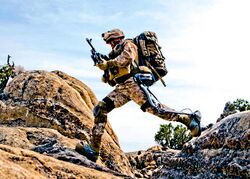
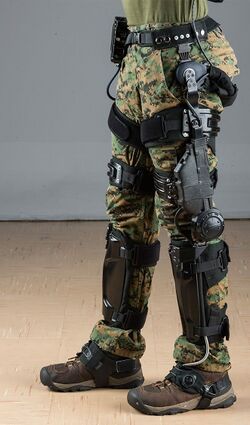
While they are still some ways off from producing a fully functional power suit, there is interest in the idea. Some people are now looking into making functional powered exoskeletons, this includes some guys in Japan and the US government. While it's initially going to be used to help do heavy lifting where heavy equipment is impractical/inadvisable, along with helping the disabled to walk once more, using it for military applications is in the works. Hell, just look at the images. The basic idea works well enough, but there are still in the experimental phases and while they got the basics of the "power" part down they have yet to add the armor. Currently the primary focus is to reduce fatigue and leg injury rather than superhuman strength, which makes sense given what the modern infantry doctrine is about. Given the desire for modularity and practicality, body armor and exoskeletons will likely come separate.
That said, they still have a fair bit to go since most early versions will be restricted by a power tether or run on batteries that have at most a few hours of juice. Still, the first airplane's flight only was about 35 meters and it took less then two decades to go from that to the first transatlantic flight.
But don't start holding your breath just yet. Though asymmetric war makes all kinds of spectacularly idiotic war toys possible, power armor will face a redundancy/nesting doll issue by placing a humanoid automata... inside of a humanoid automata. Since the goal is to protect the former "automata", why place it inside the latter? Direct piloting, as opposed to remote, will likely have little affect on the frames overall combat effectiveness. However neither are mutually exclusive to each other so exoskeleton equipped troops may become a thing if it's treated in the same sense body armor is: Something that helps, not as a crutch.
USSOCOM has canned their Telos Exoskeleton program, primarily because despite all the R&D invested into the program, researchers have been unable to find a power source compact and powerful enough to allow the suit to operate for extended amounts of time outside of a power station. Its simply a lot cheaper and feasible to improve upon practical, existing technologies to augment the combat effectiveness of troops, than it is to find a way to make exosuits practical. Lockheed Martin's developing their own program called the Onyx, and instead uses a AI to regulate the exosuit's strength in order save on power, although its only for the legs as of the moment and is also still under review by the US armed forces.
Russia's Ratnik program is still on-going, although the current iteration does not have any actual power armor and instead gave troops an advanced array of electronics, gear, auxiliary equipment and body armor, which is closer to the US' Future Soldier program than anything else. China has their own unnamed exoskeleton program, and has a state-made demo video of soldiers using them to carry heavy loads to demonstrate the suit's strength-augmenting abilities, but its unknown if it actually works past menial labor since there hasn't been a video of them in a combat scenario (or if they work at all, to begin with).
Fantasy in General
Depending on who you ask, any magic armor that increases your speed and strength and has spells that counteract encumbrance bound to it could be considered a form of power armor, especially if it's full plate armor and particularly if it has some system to keep out nasty shit like drowning, poison gas, or the vacuum of space.
It is armor, and it is using a power source in the form of magic to enhance the wielder. More traditional power armor can also be found in fantasy; particularly in settings that are at least to a clockpunk level of technological development, often using magic or just not caring enough about physics to allow power suits to function with technology like steam boilers, clockwork gears, and diesel engines or simply running off of magical energy.
This particular trend has started to become more common as more and more fantasy writers have started to rebel against the concept of medieval stasis and even in settings that don't just outright abandon the faux-medieval trappings of fantasy try to incorporate more in the ways of technological development or practical magic. In warhammer fantasy perhaps the most famous suit of power armor belongs to Ikit Claw, an ingenious device that is powered by warp stone and comes complete with an arm cannon to fire off warp lightning.
It is not an uncommon fantasy trope, and typically shows up to show that the fantasy world is 'advanced'.
Gallery
-
The first five Marks through the ages.
-
Diagram of Aquila armour components.
-
Eternal Crusade concept art. Again, fitting real snugly.
-
It actually fits! Still a bit unsure about those hips though.
-
Japan's take on the Marauder Suit.
| Medieval Weaponry | |
|---|---|
| Melee Weapons: |
Battleaxe - Dagger - Lance - Mace - Club Pole-arm - Spear - Sword - Warhammer |
| Ranged Weapons: |
Blowgun - Bows and Arrows - Cannon Crossbow - Firearm - Rocket - Shuriken - Sling - Incendiary Weapons - Artillery |
| Armor: | Armor - Fantasy Armor - Helmet - Pauldron - Shield |



